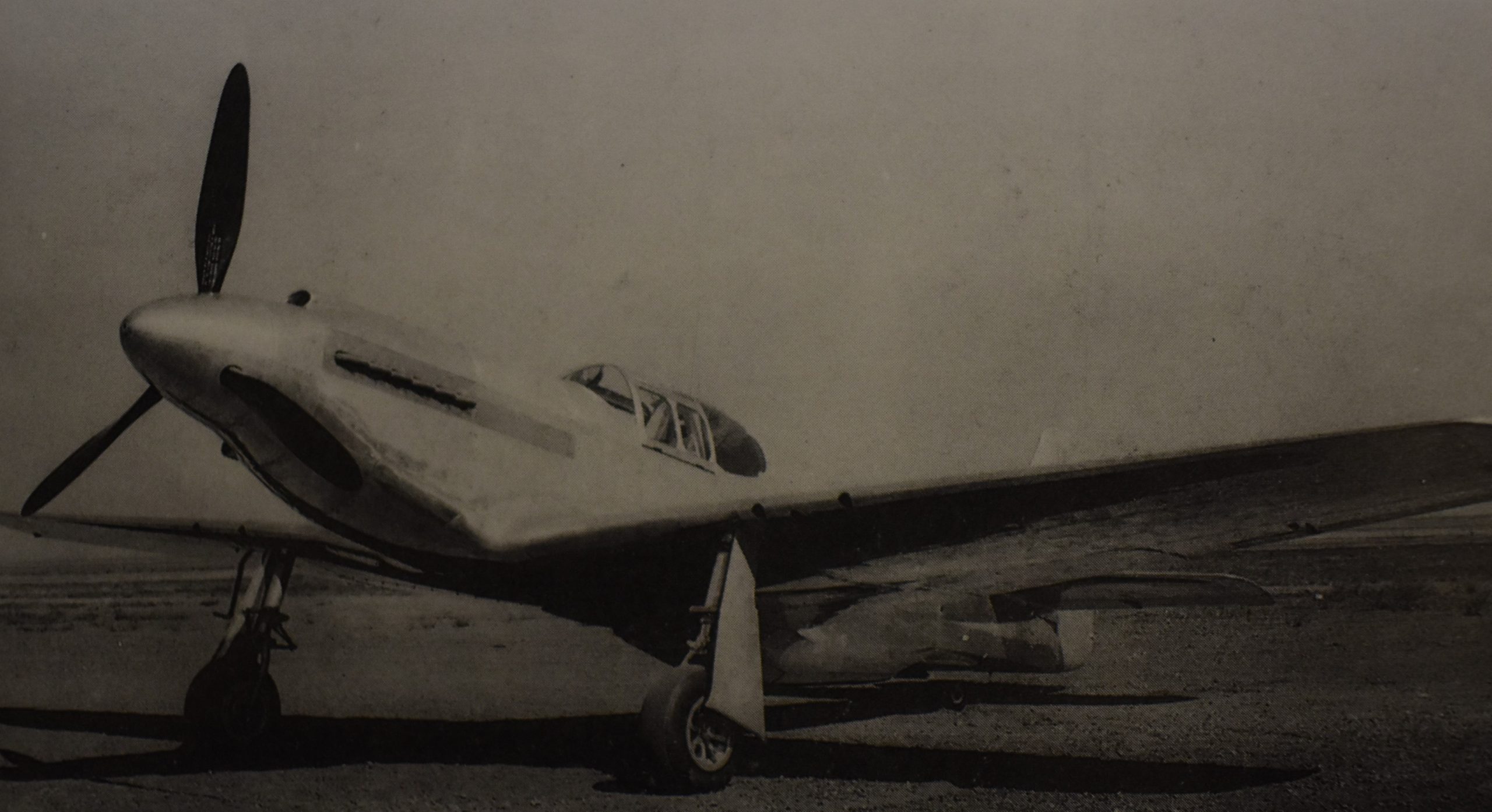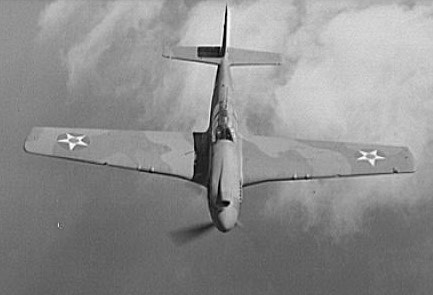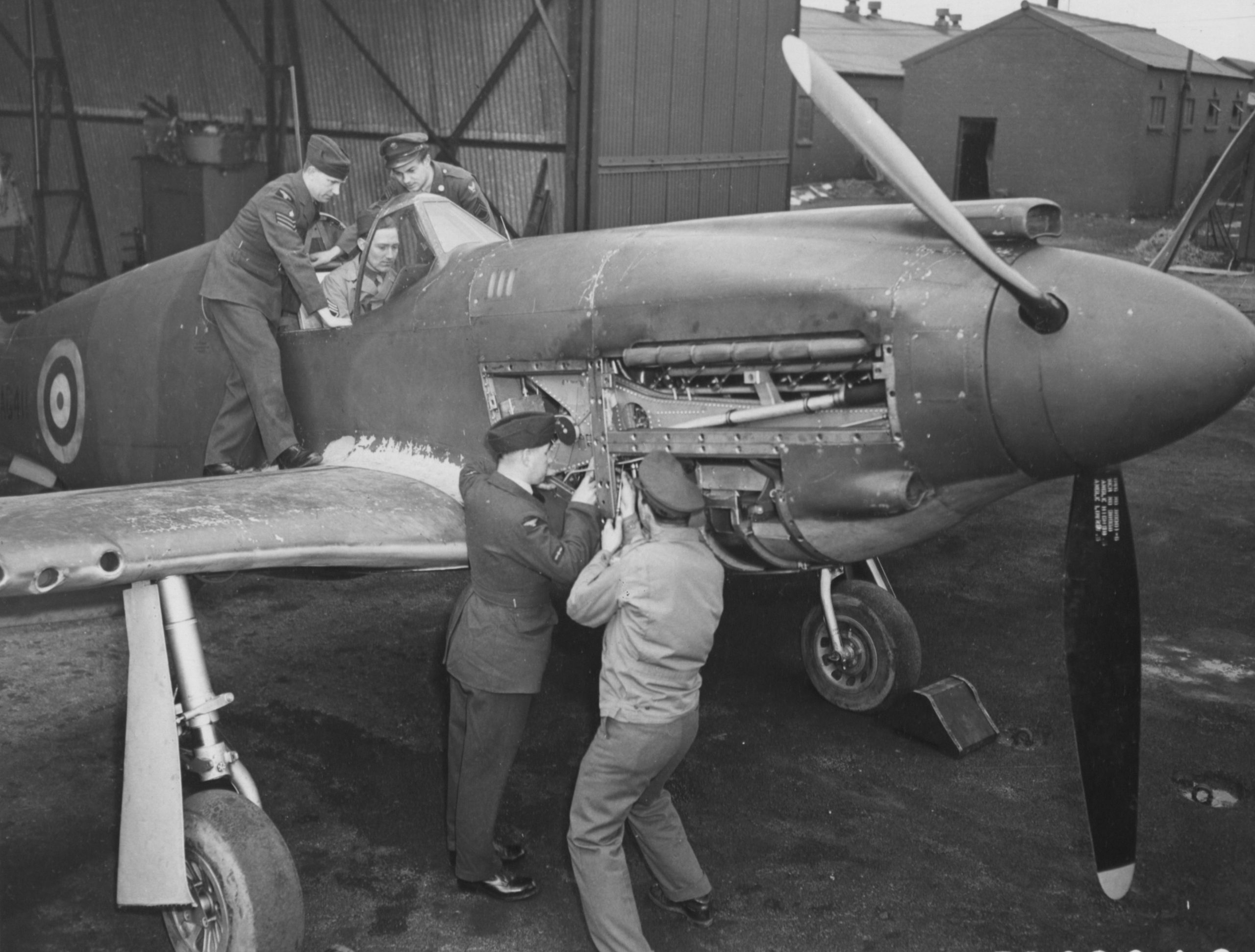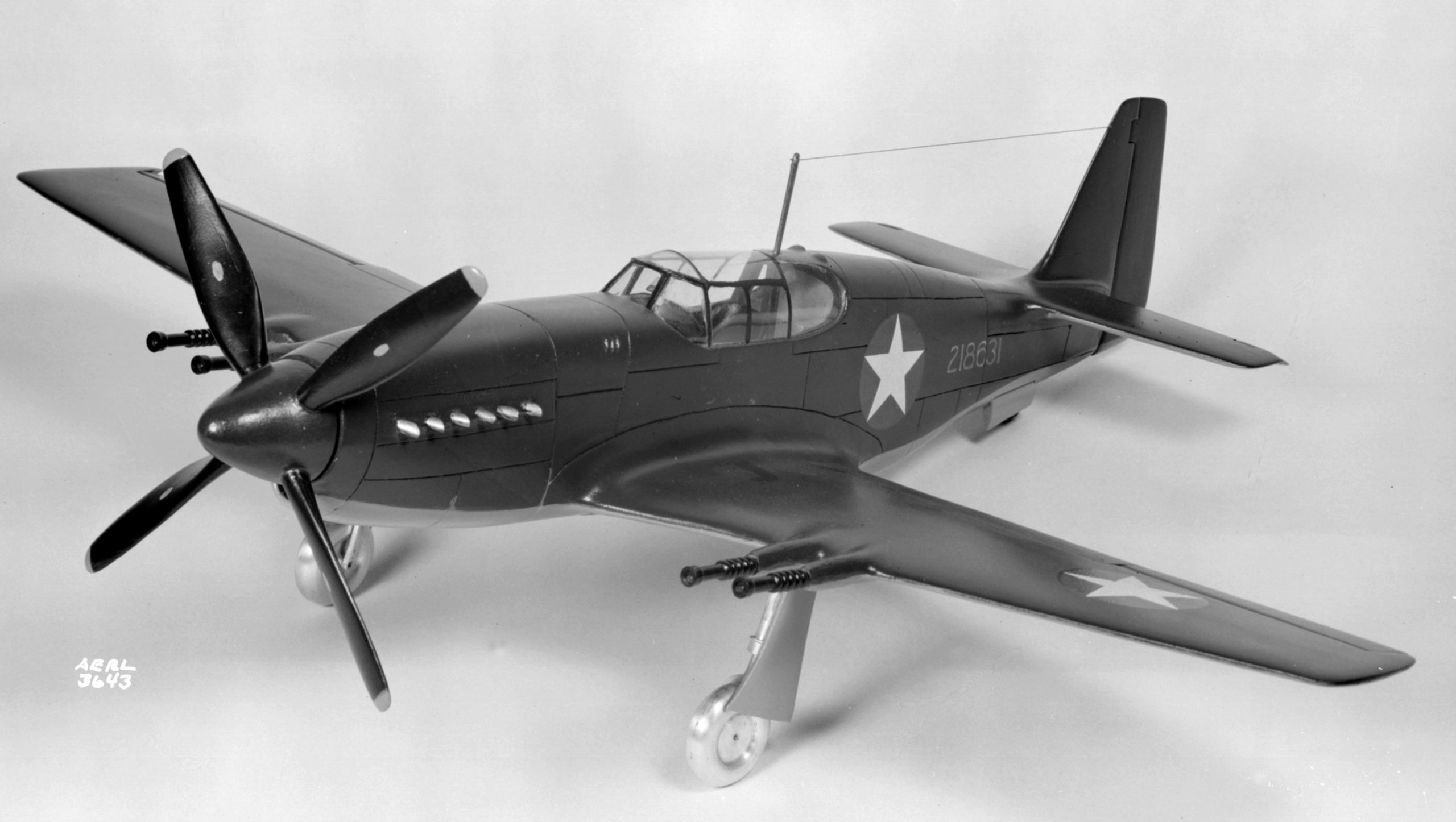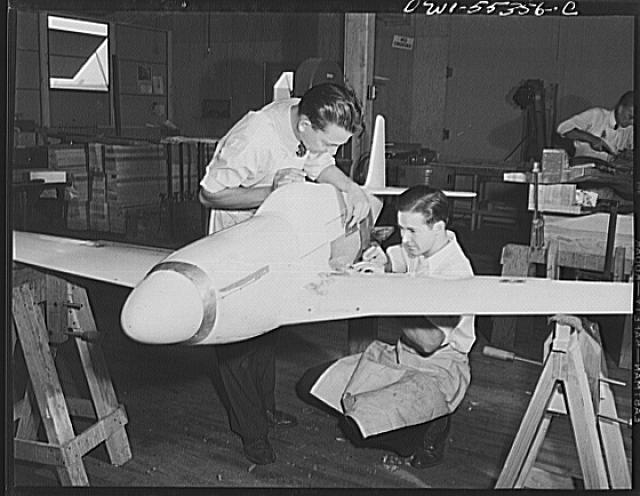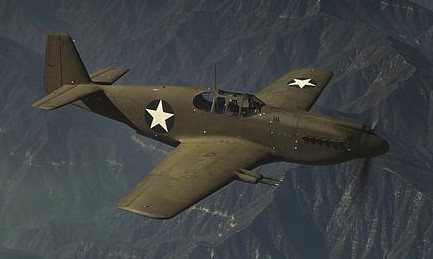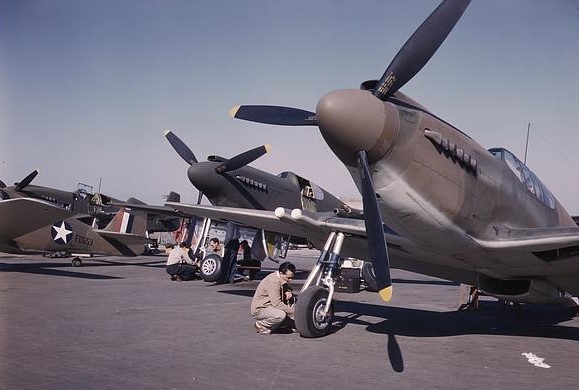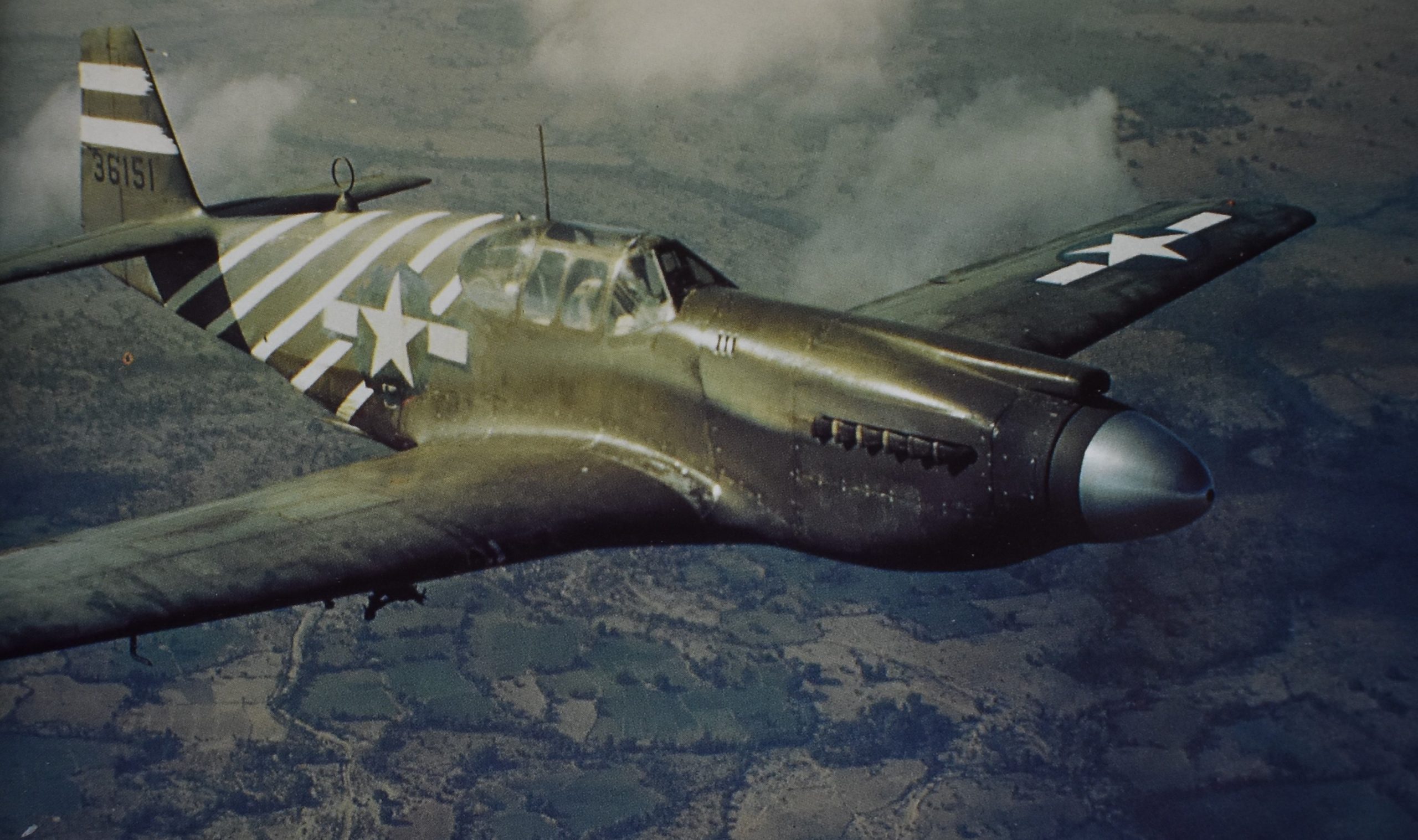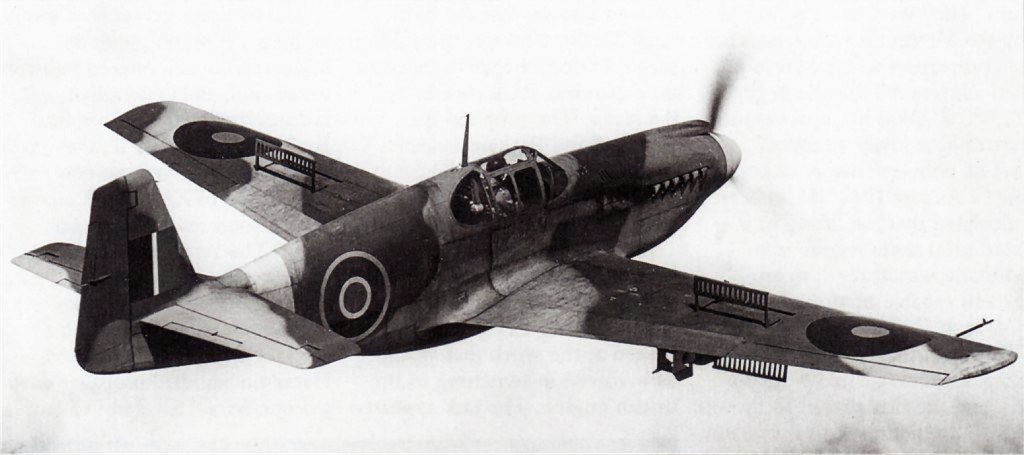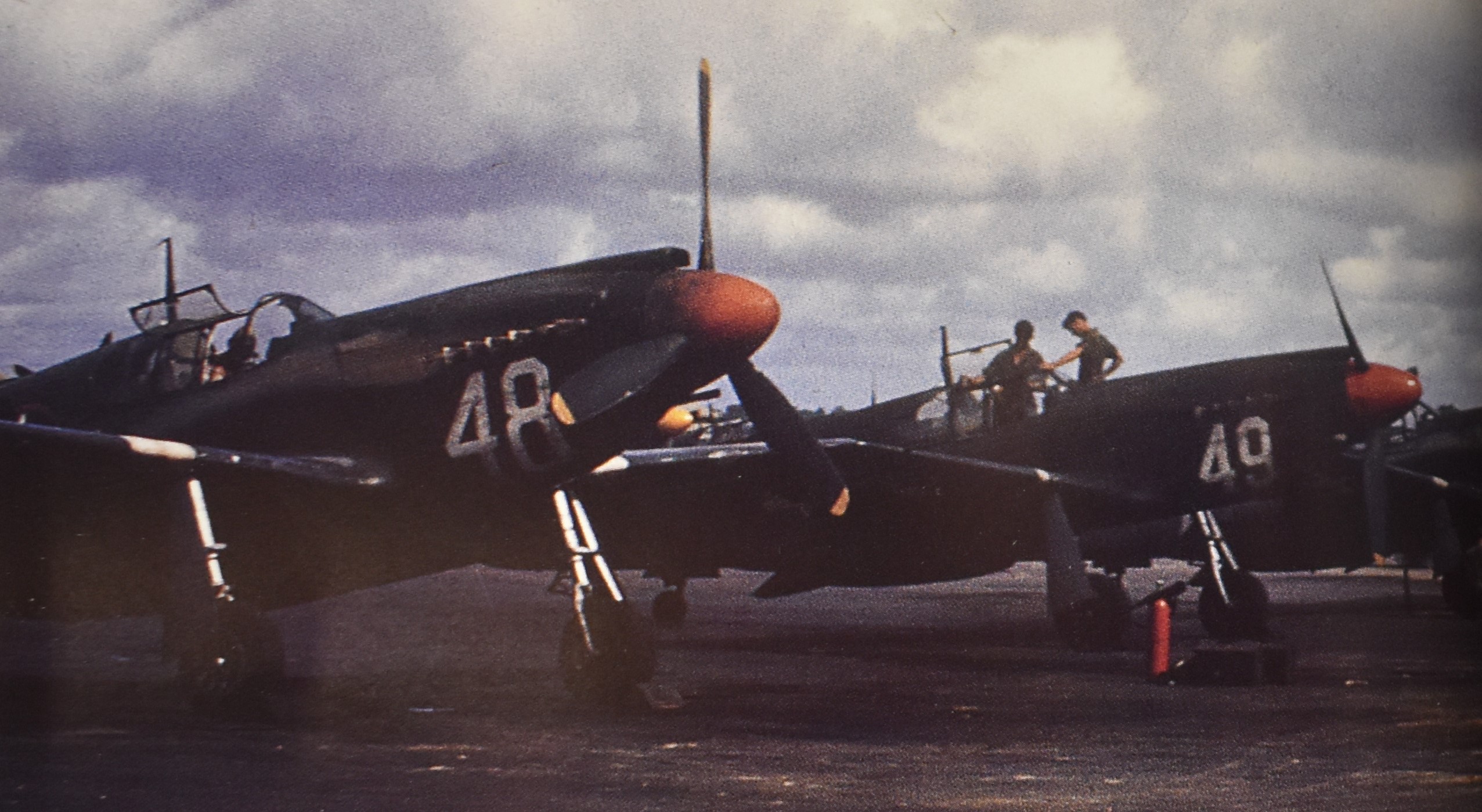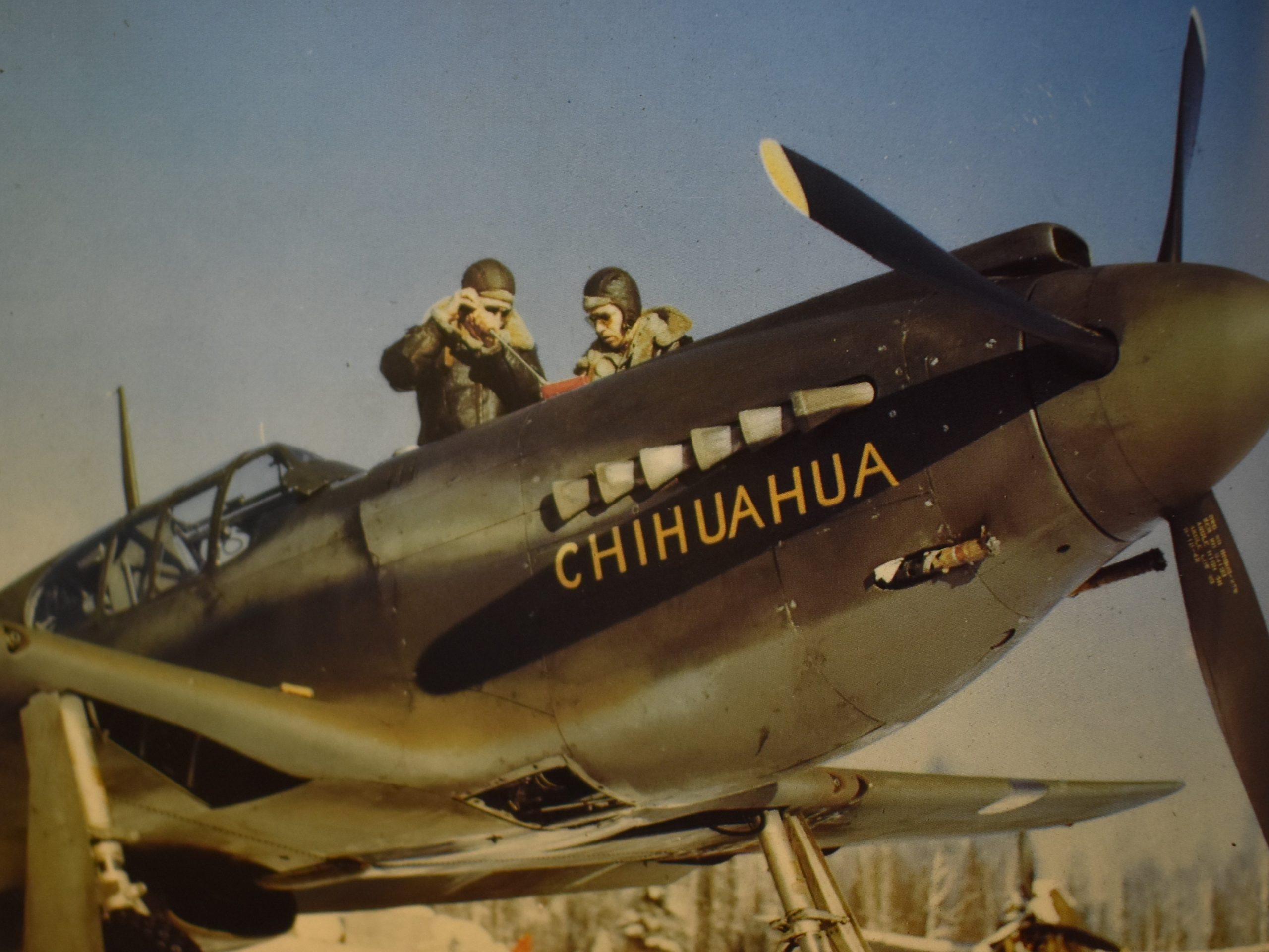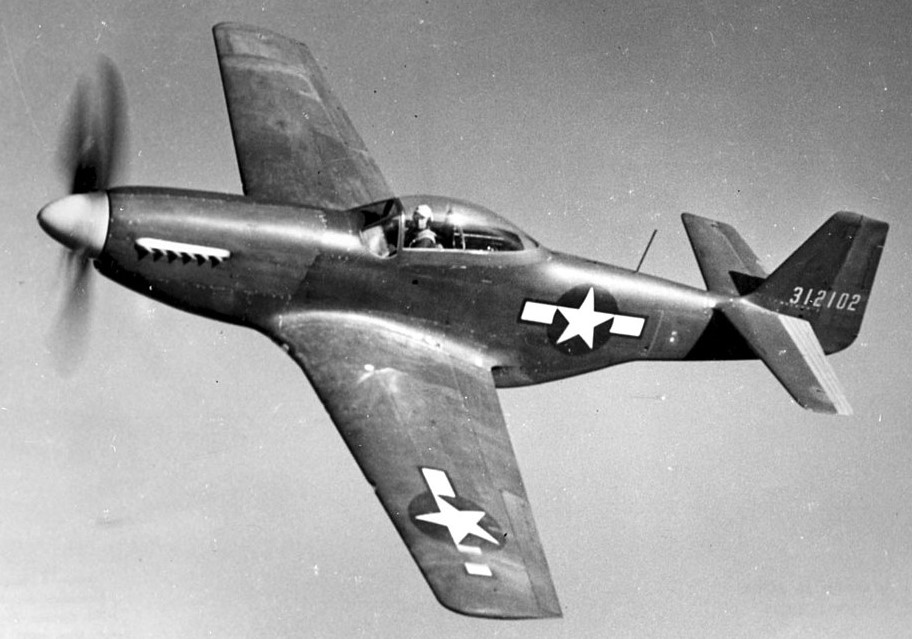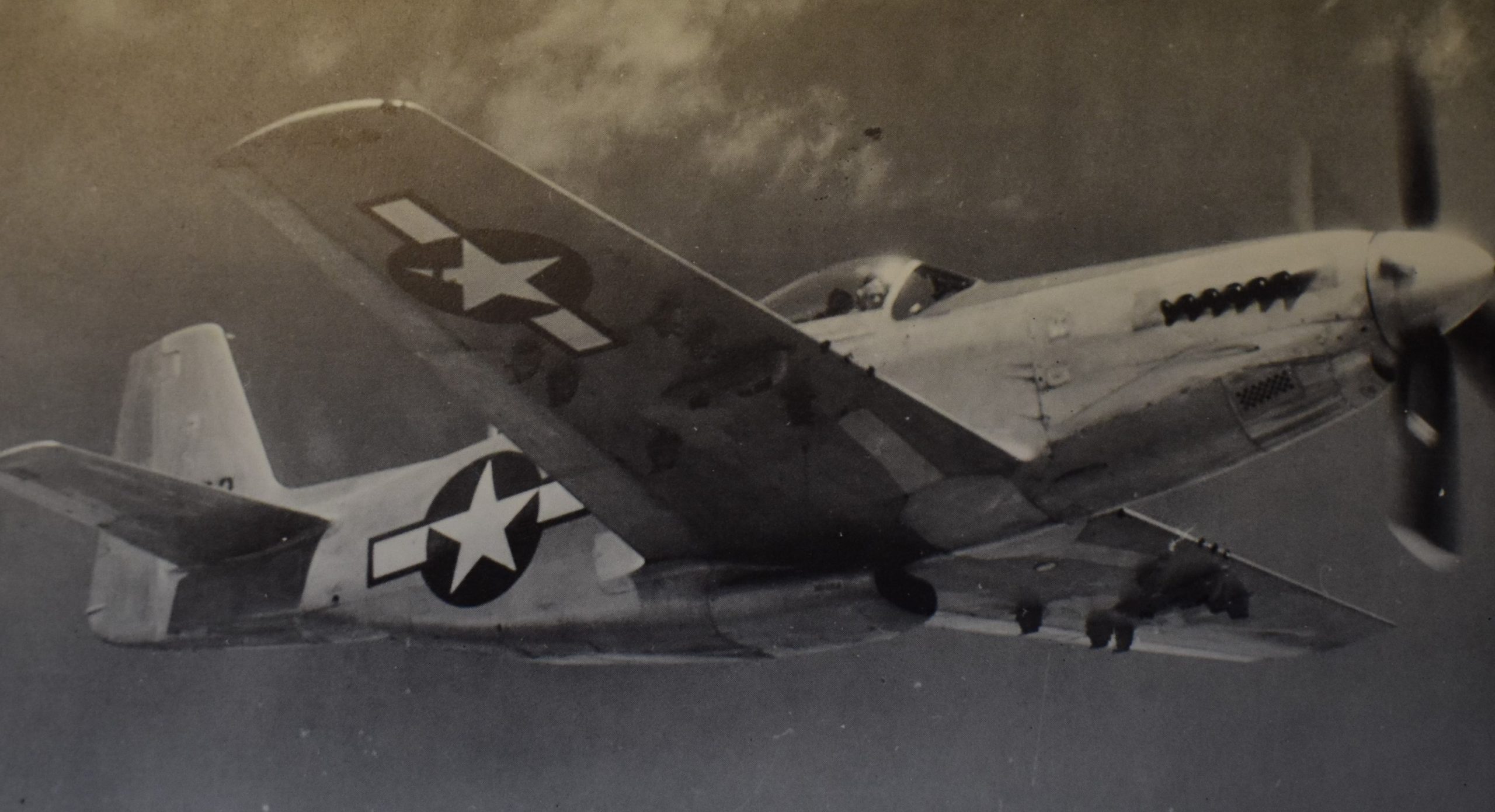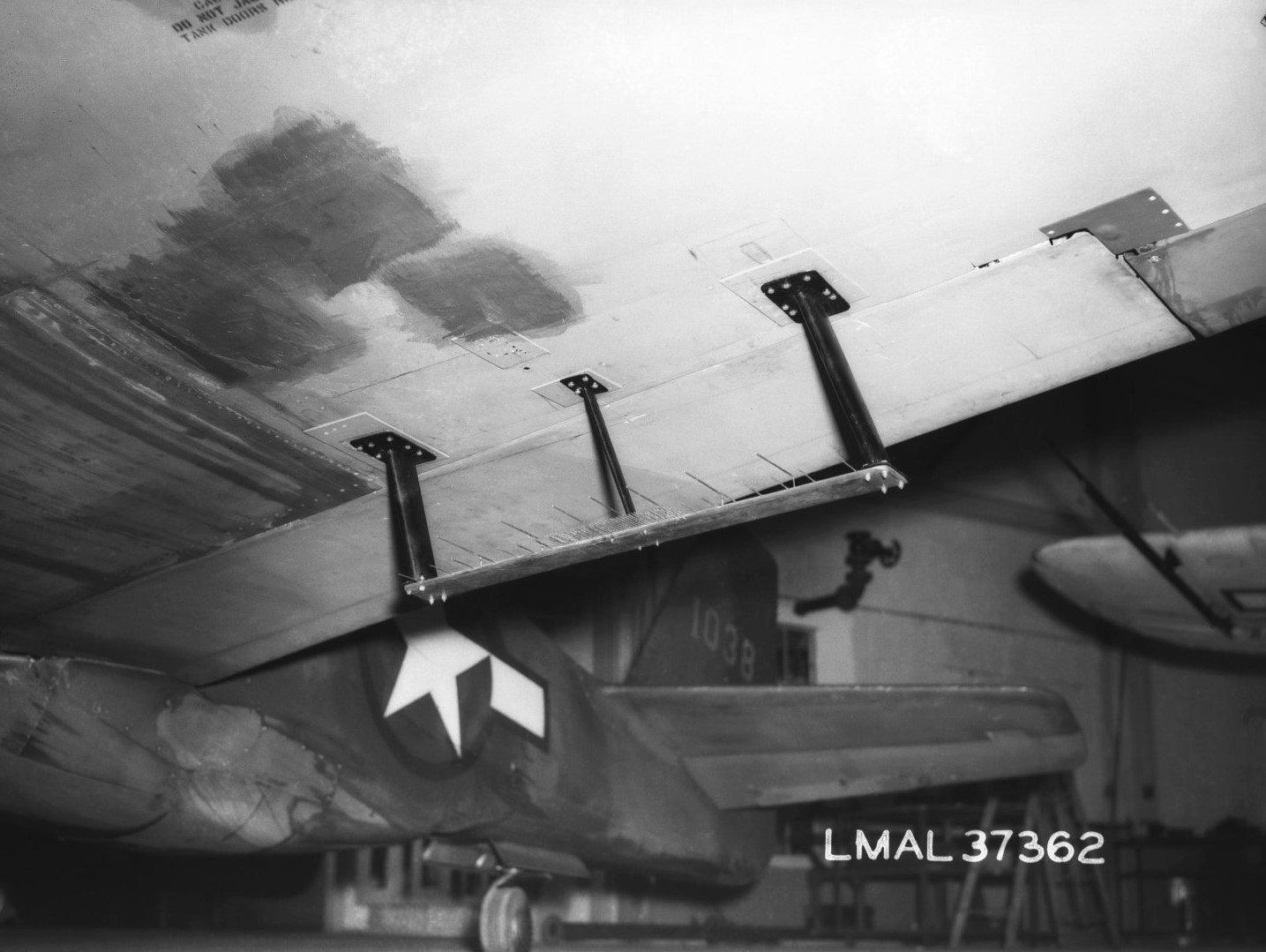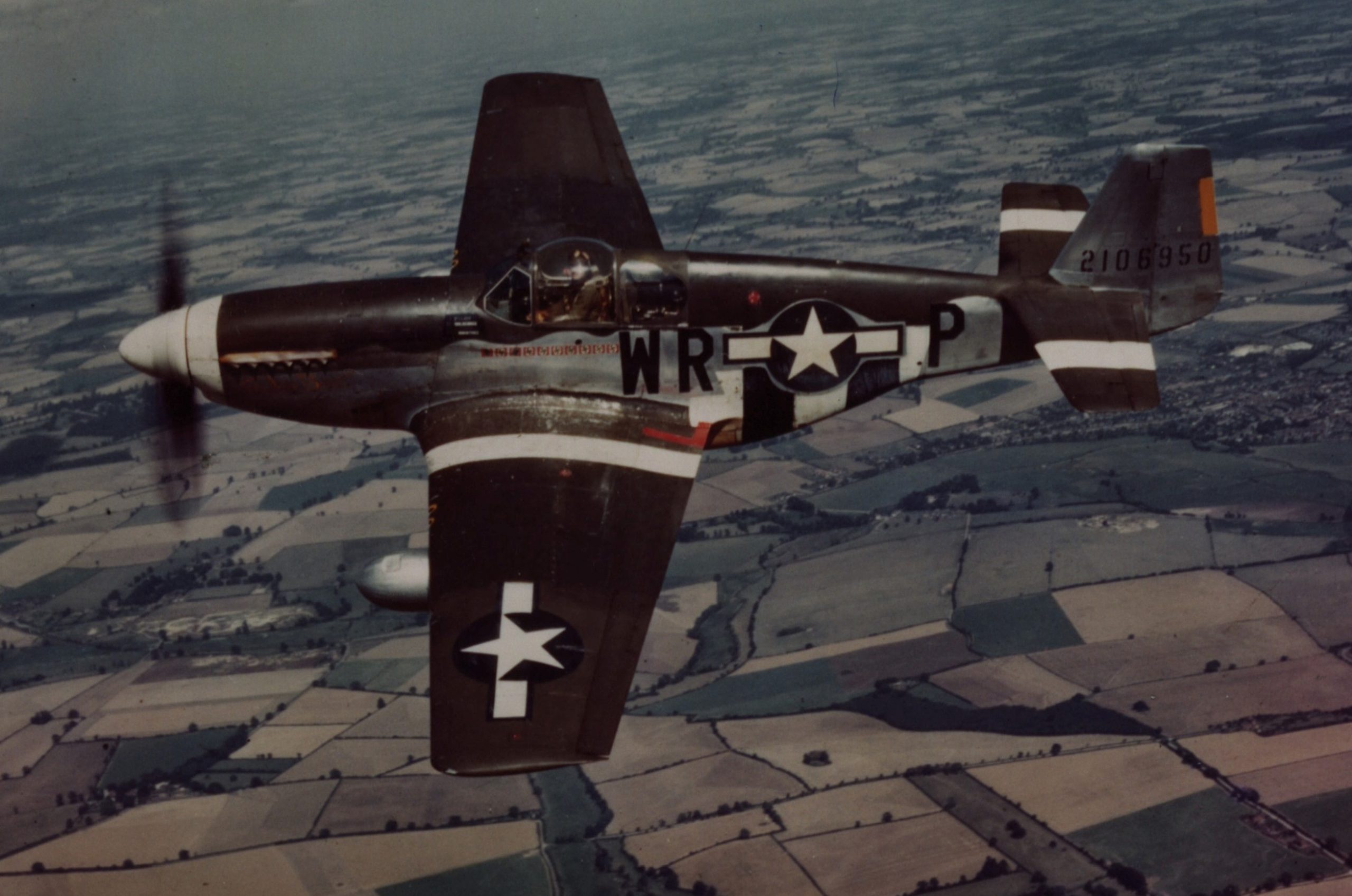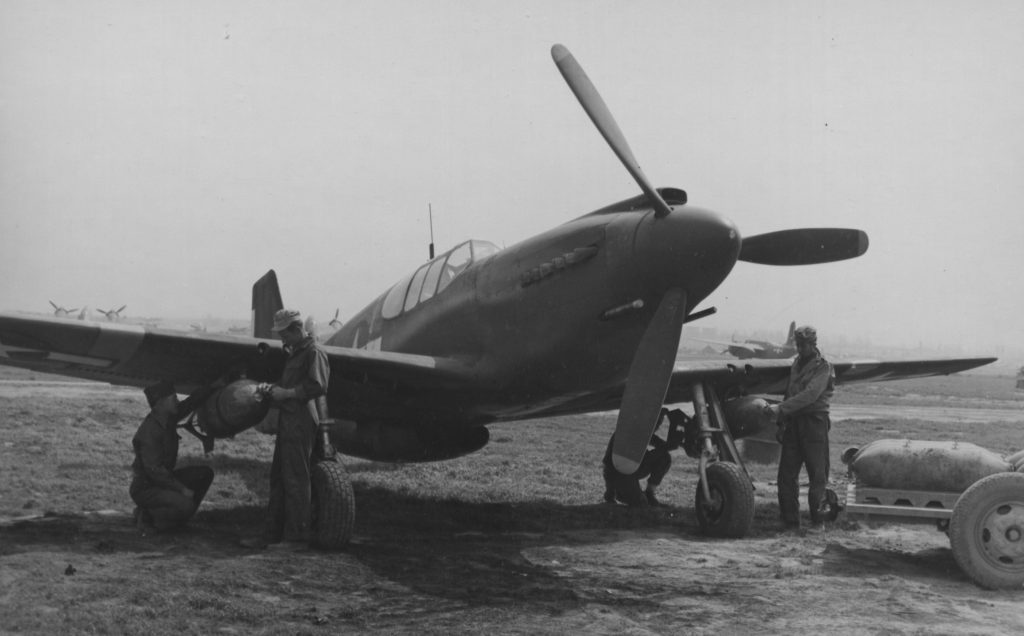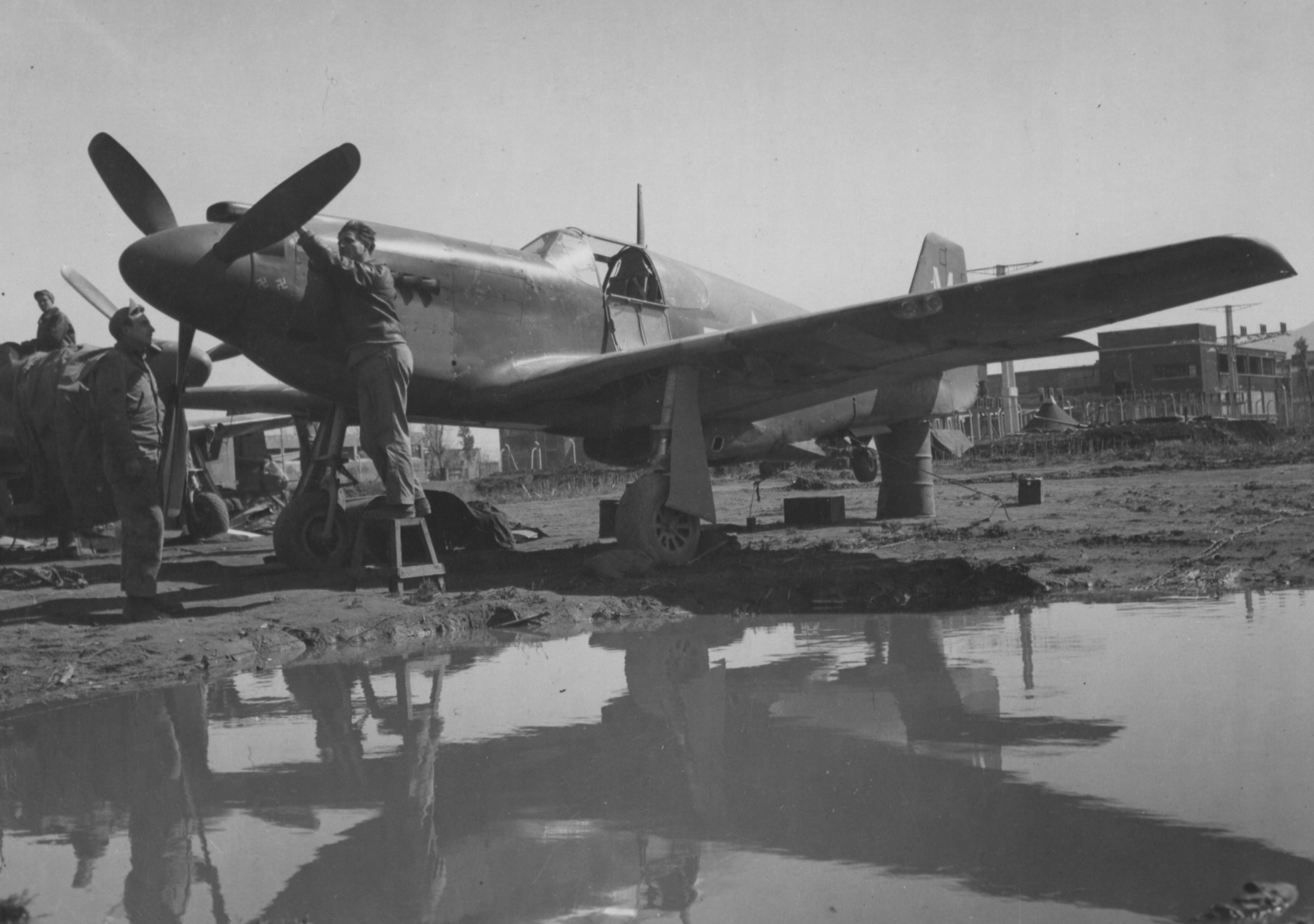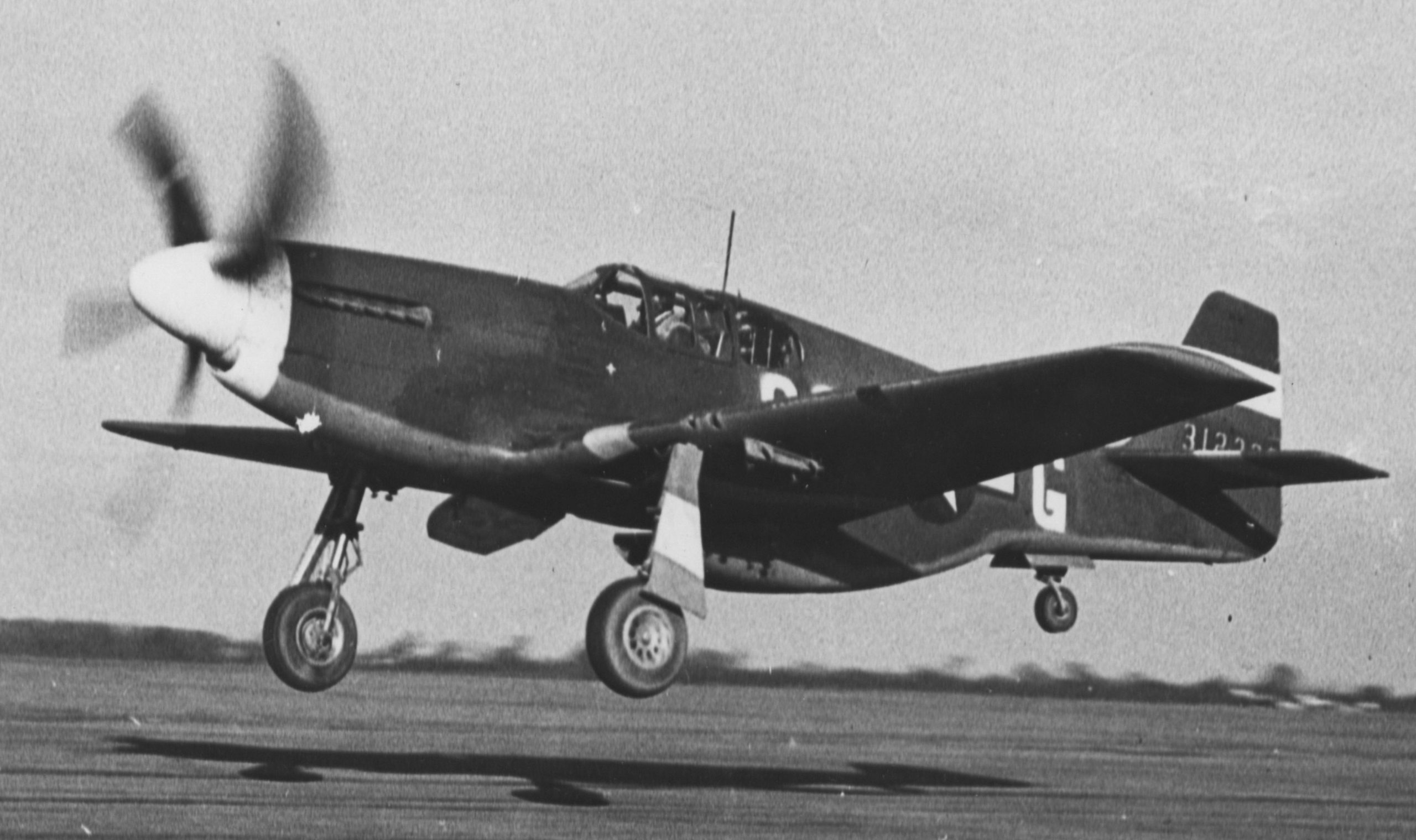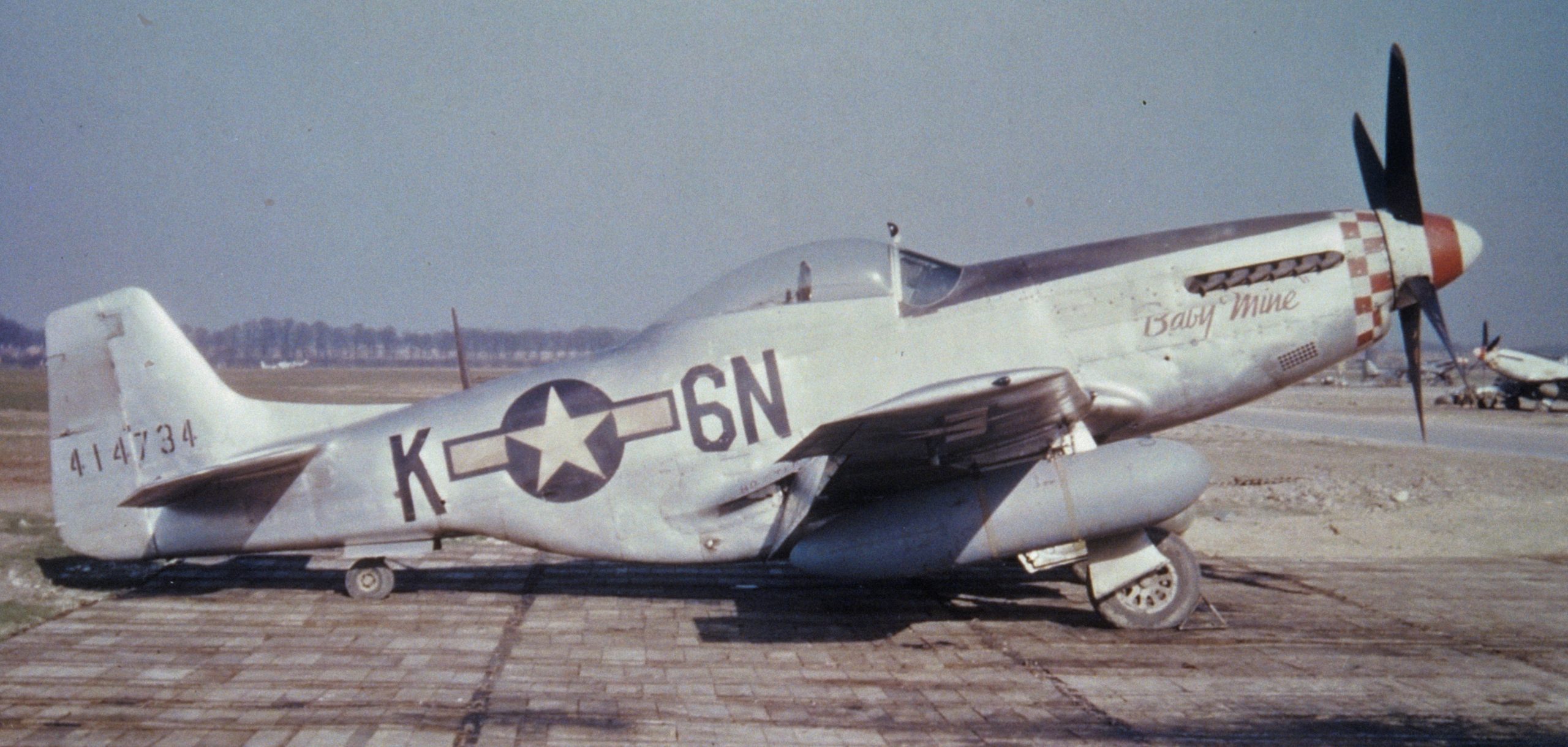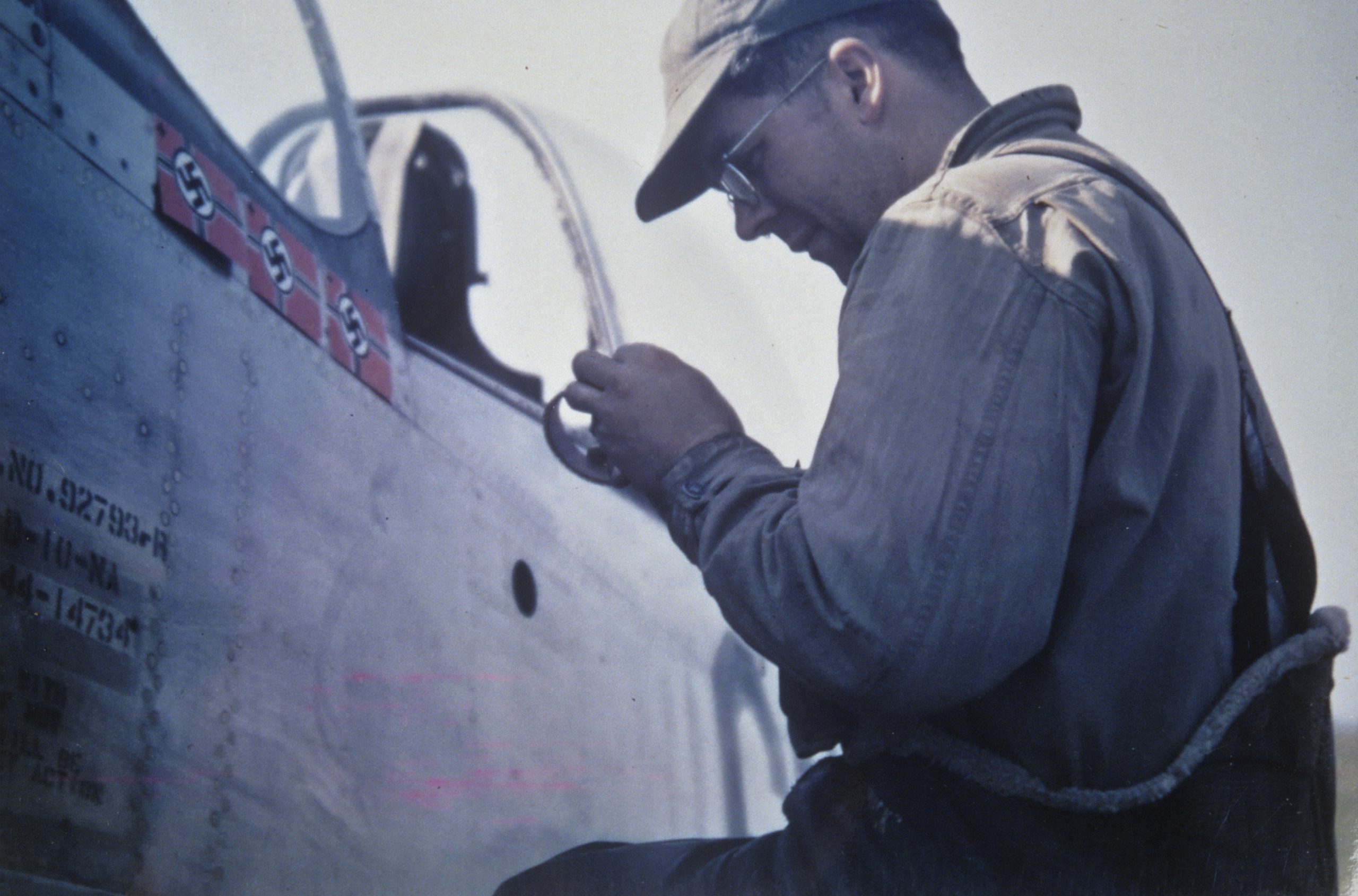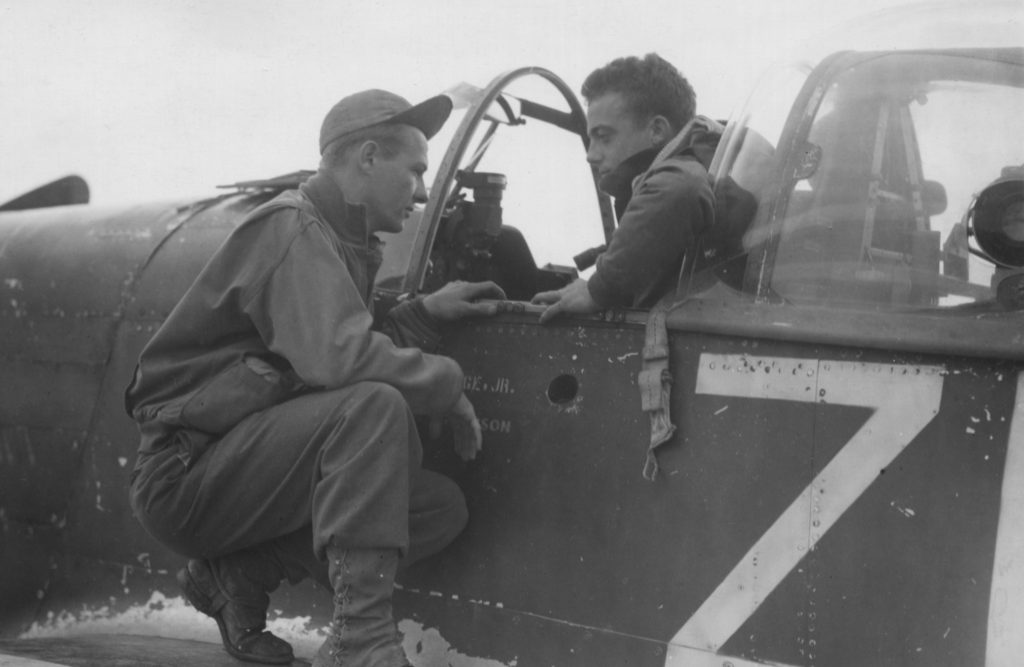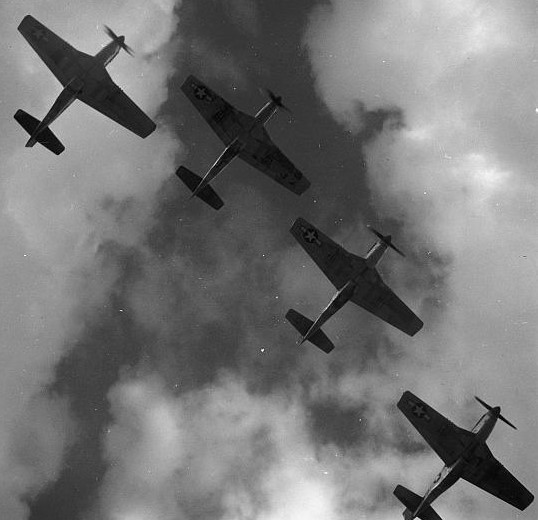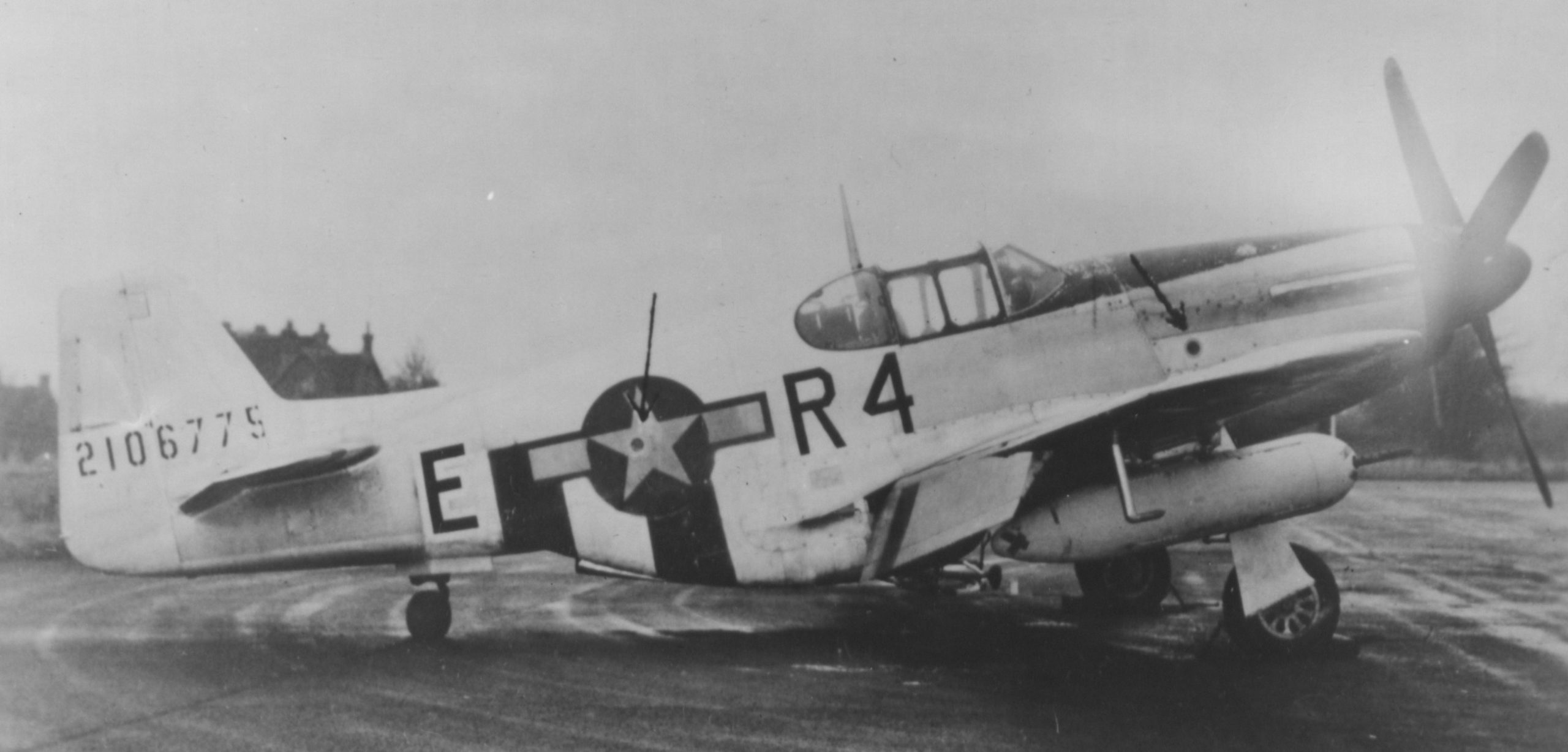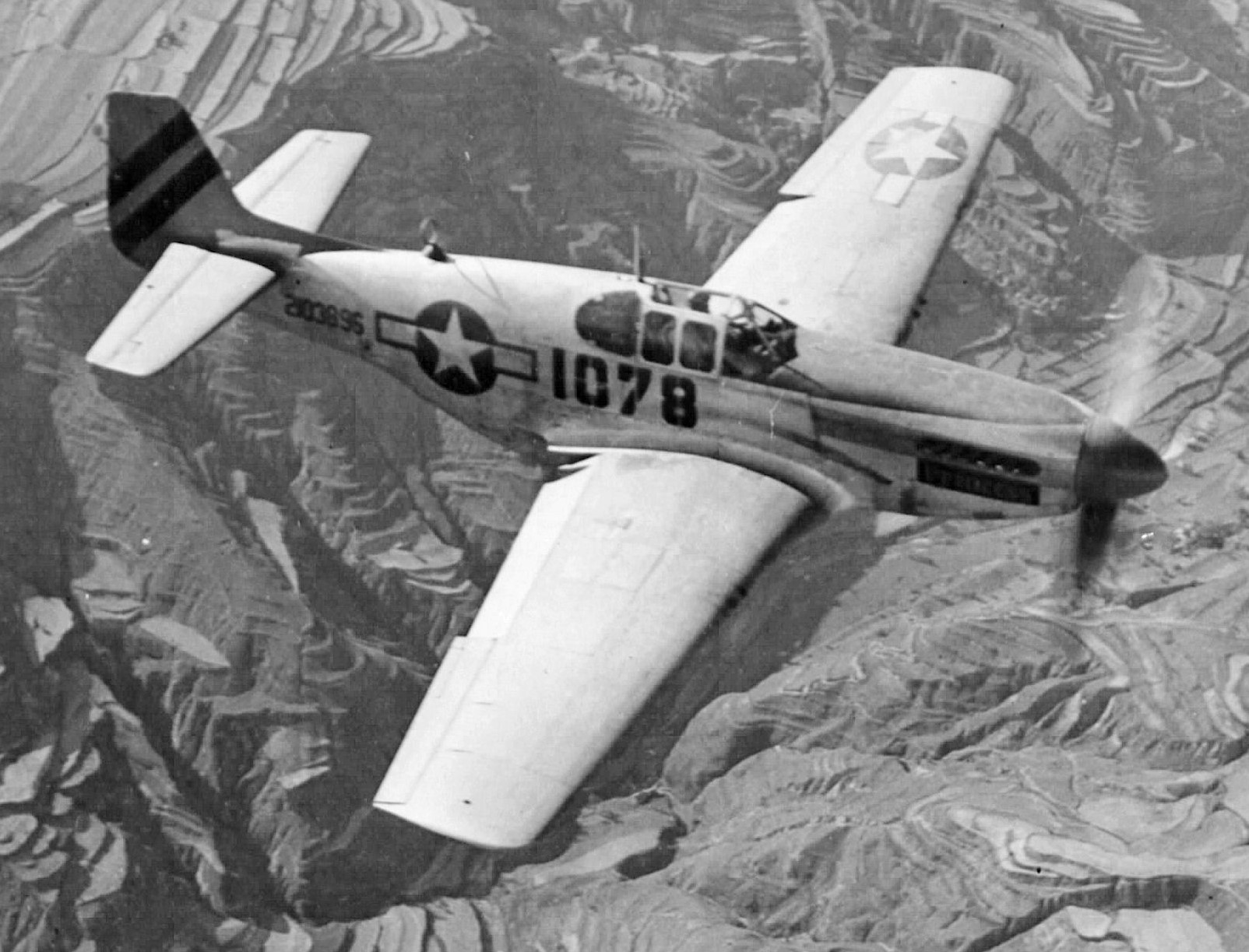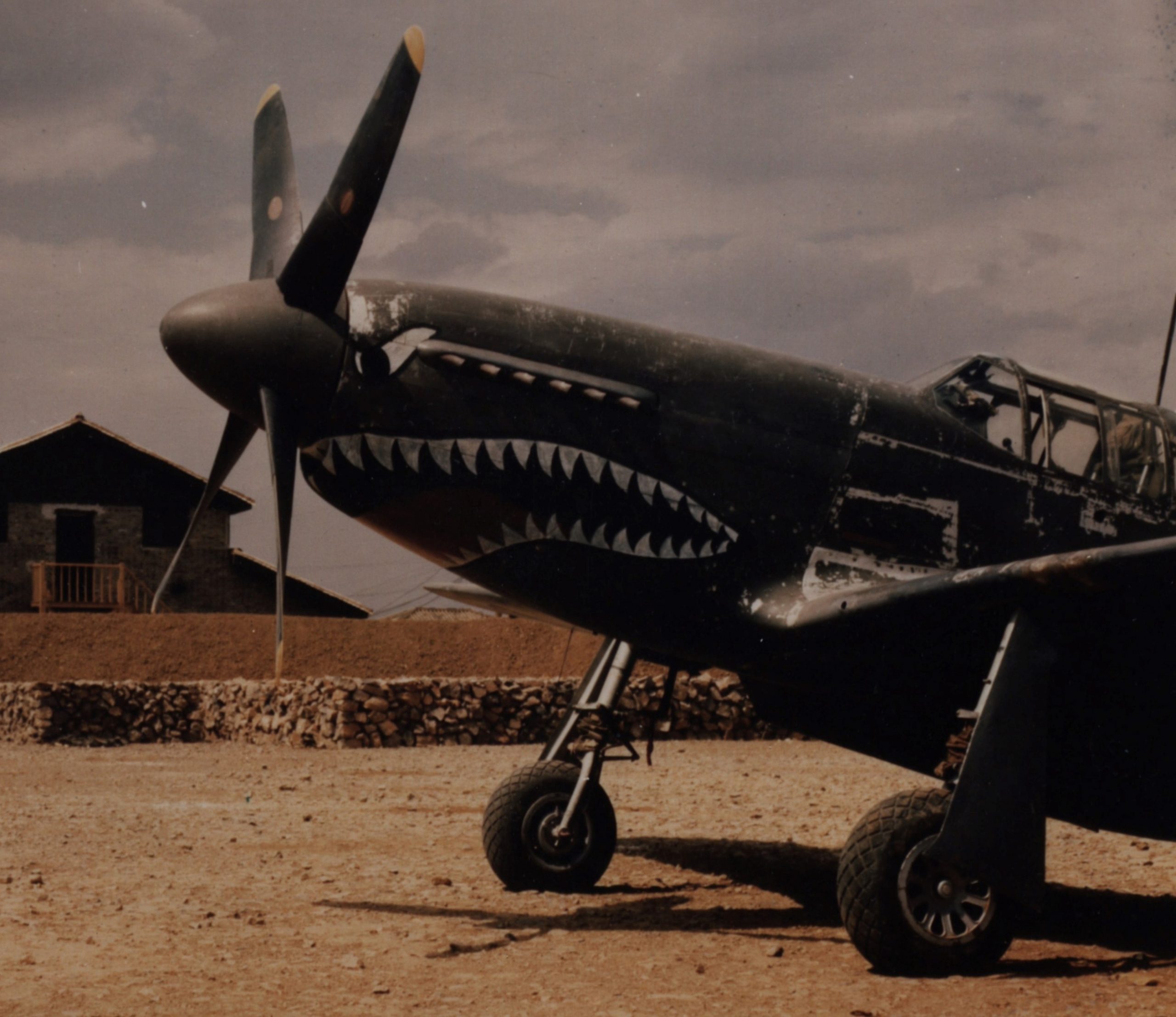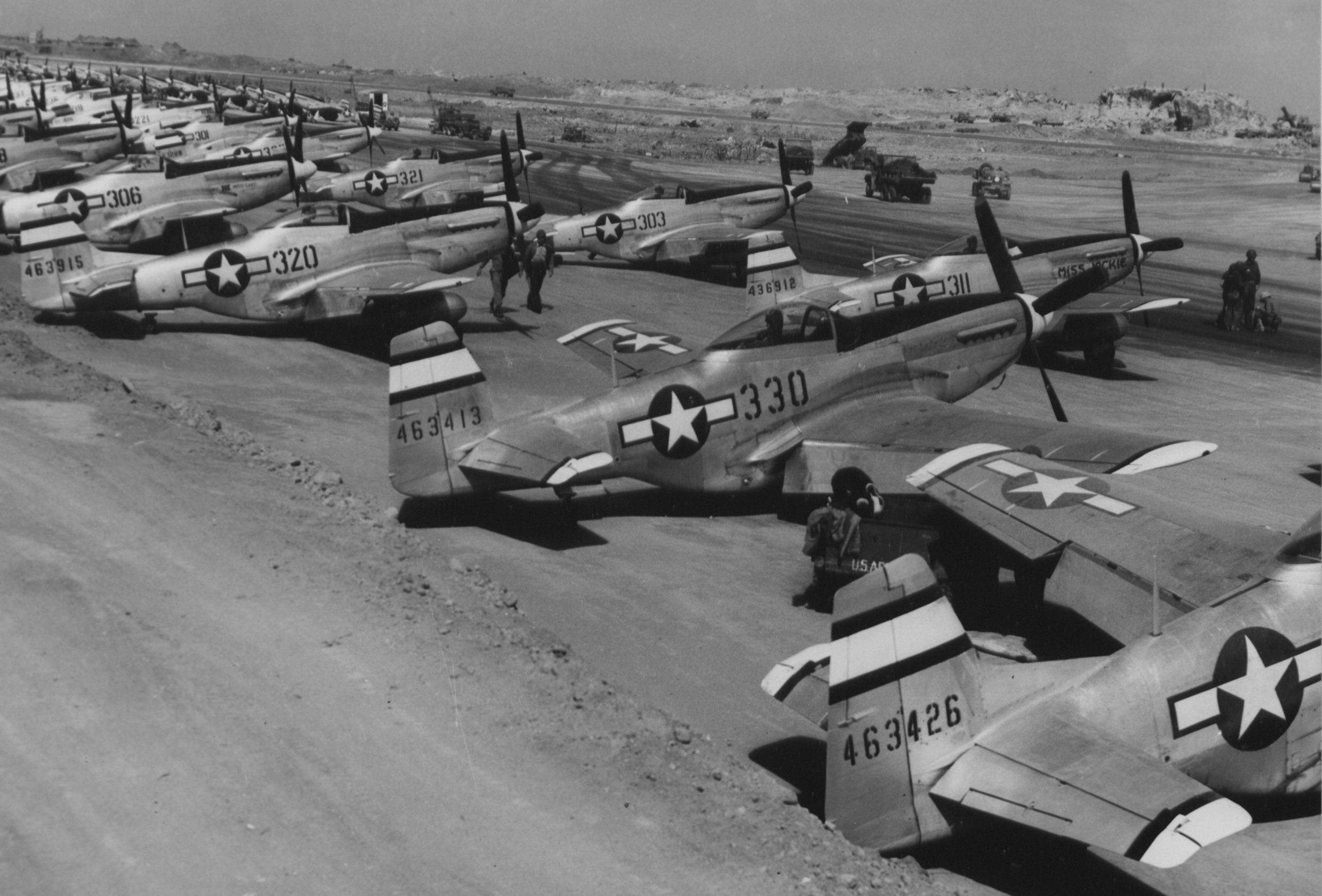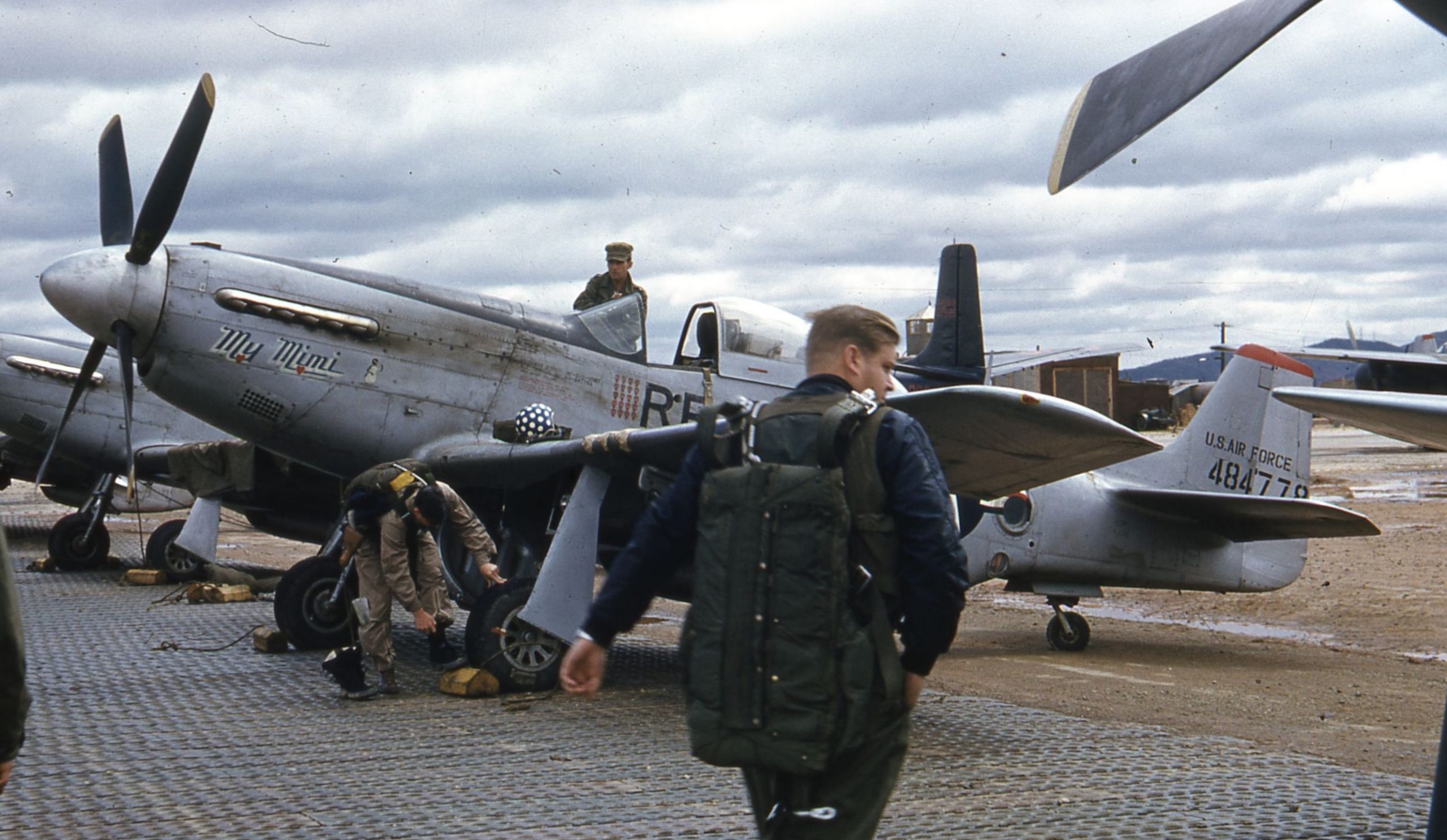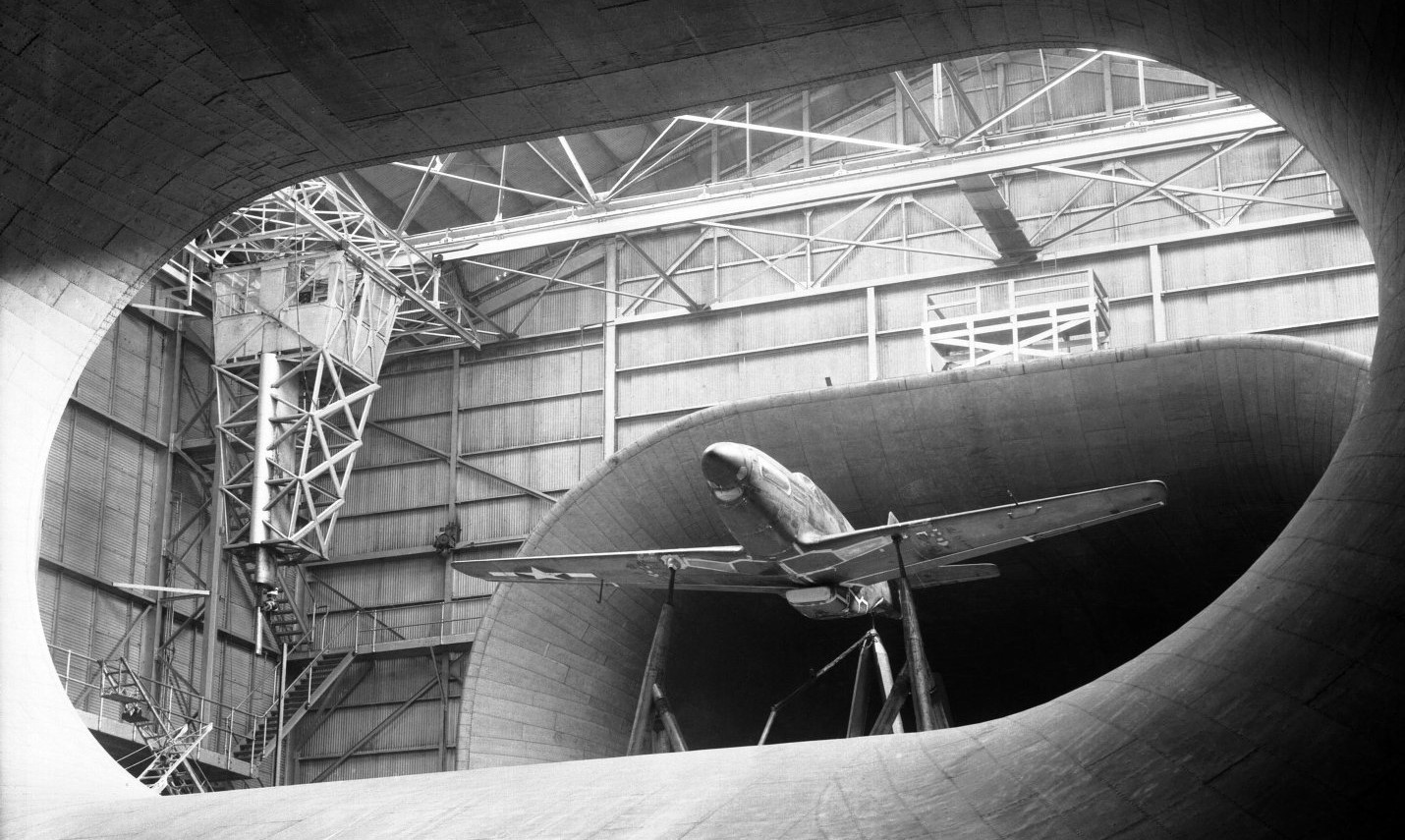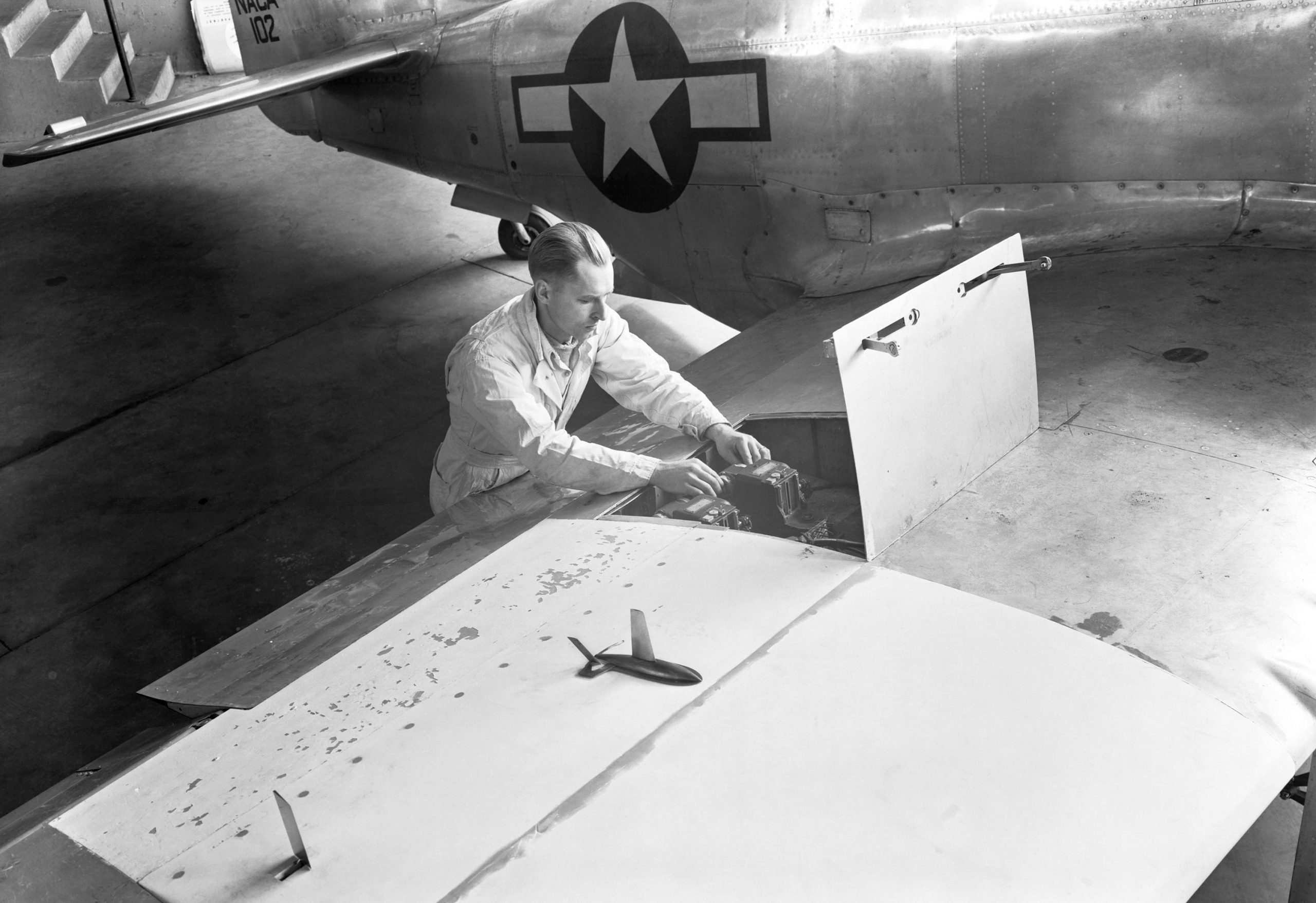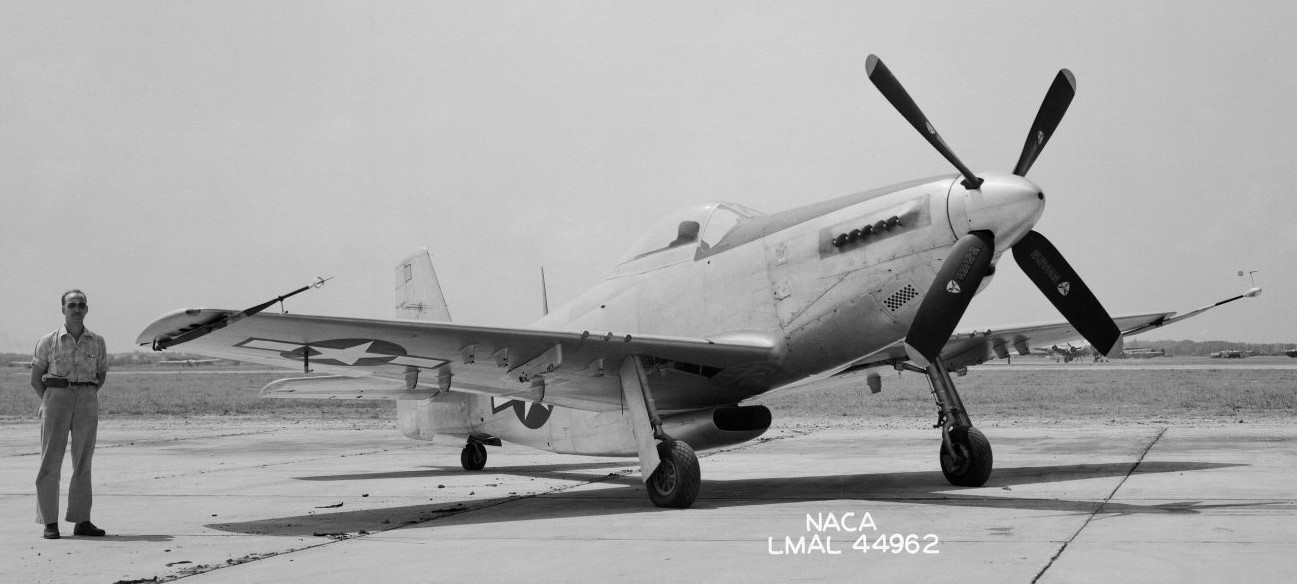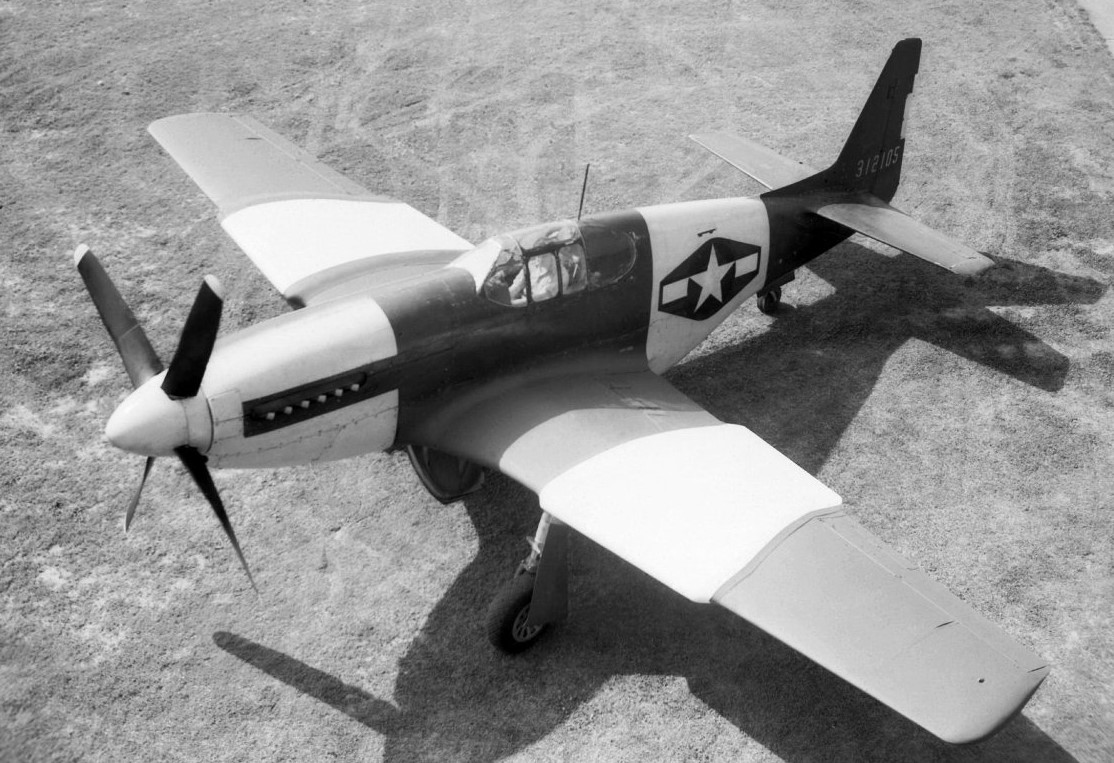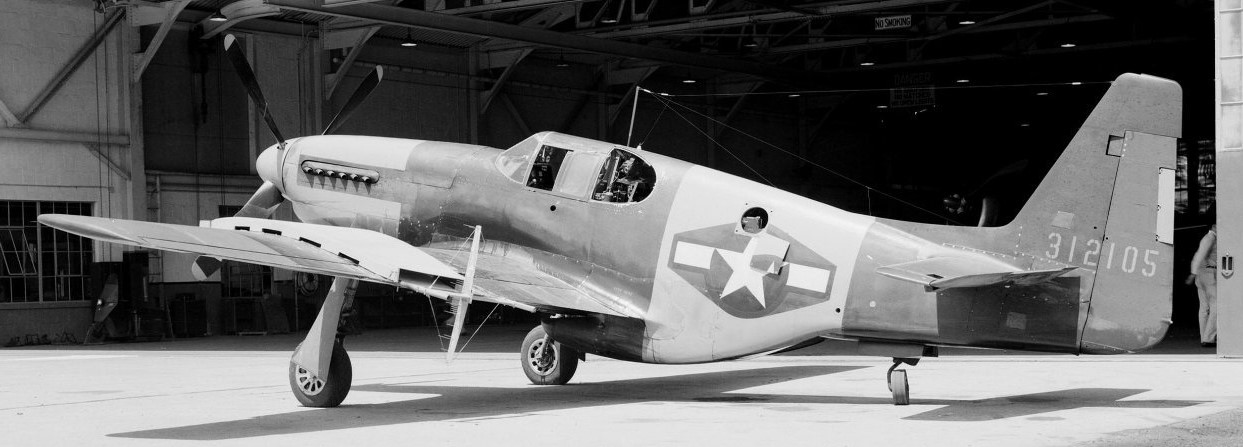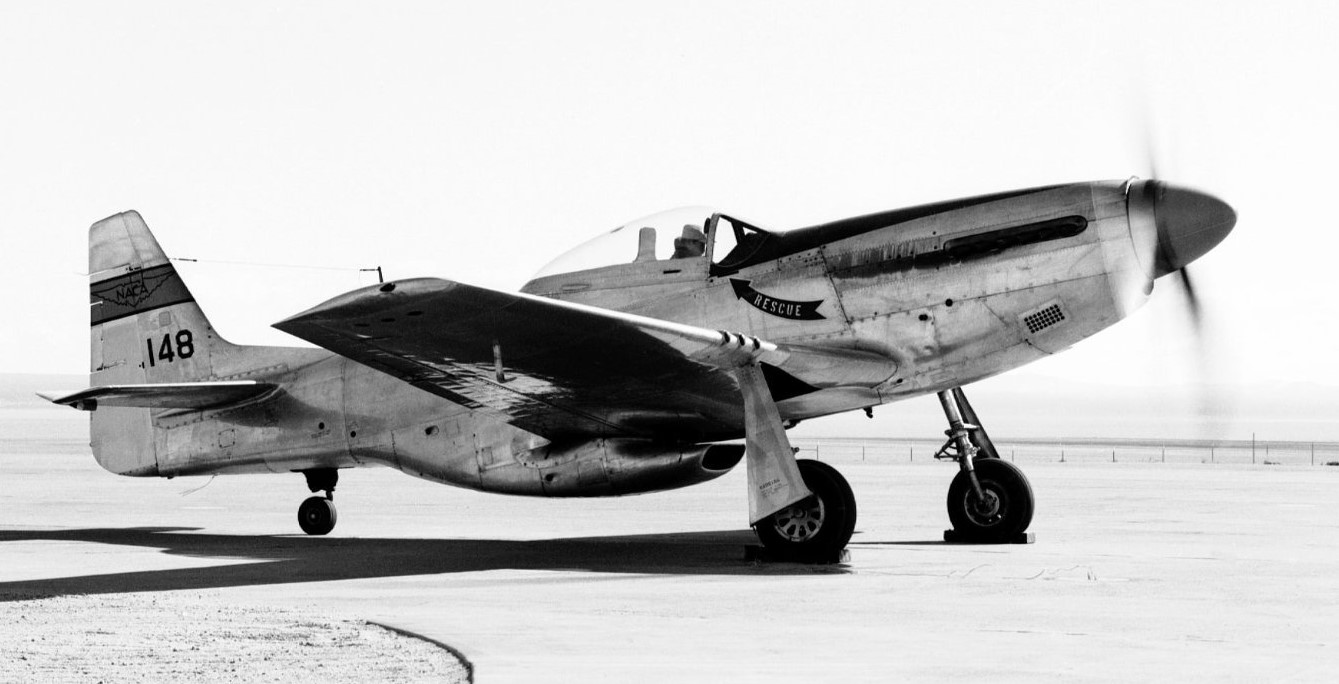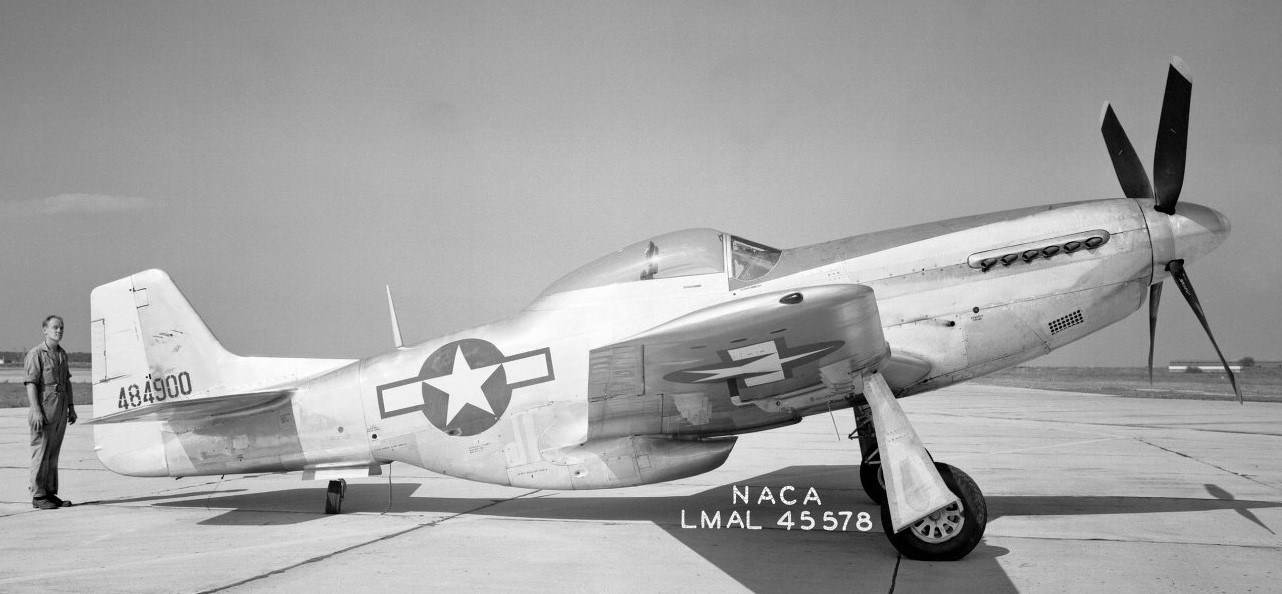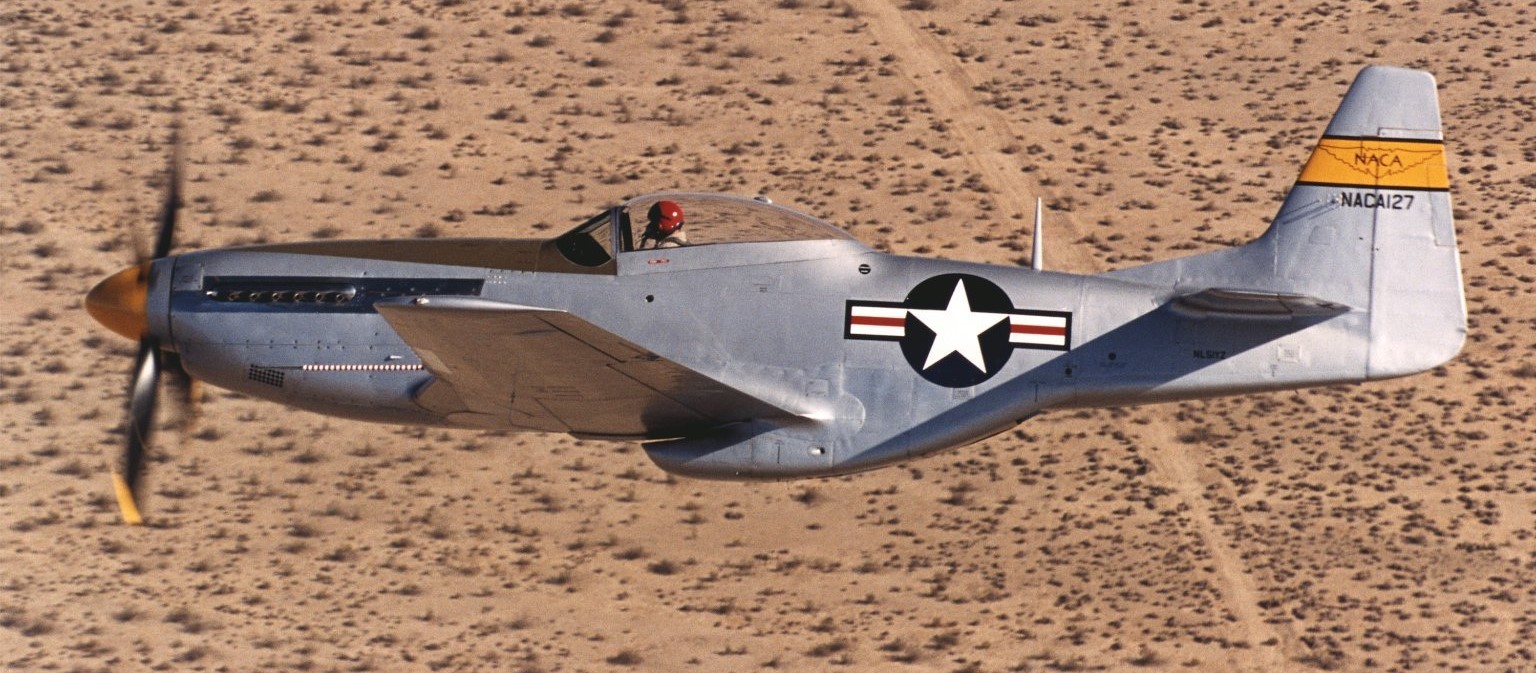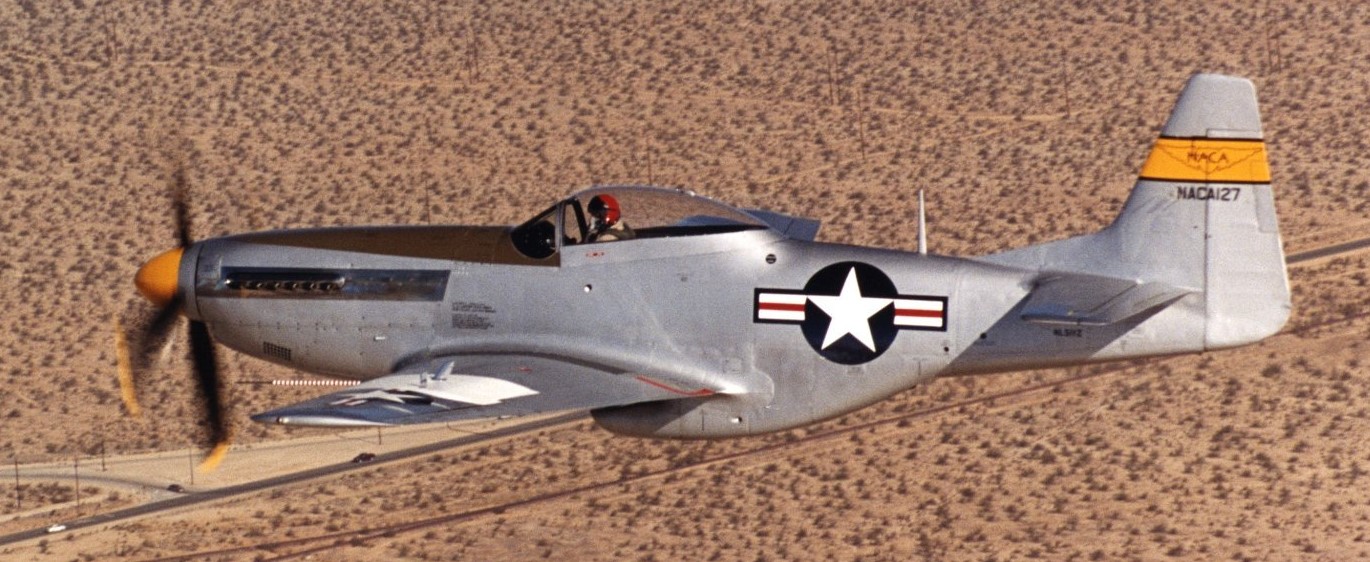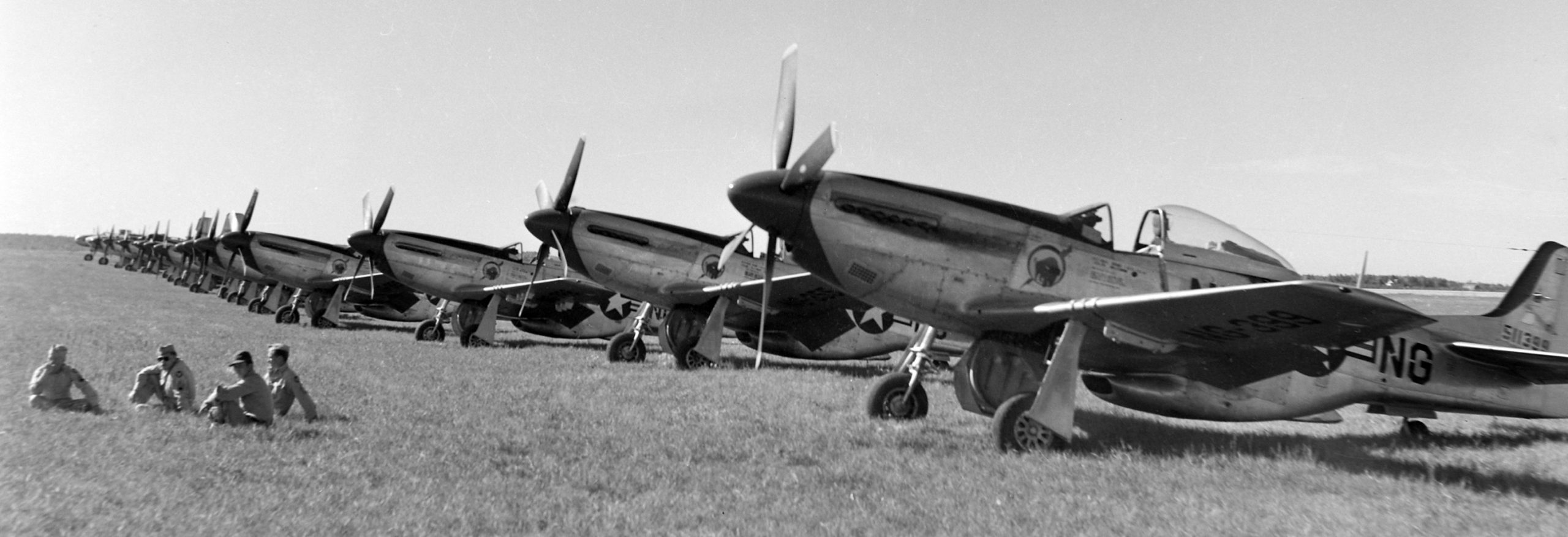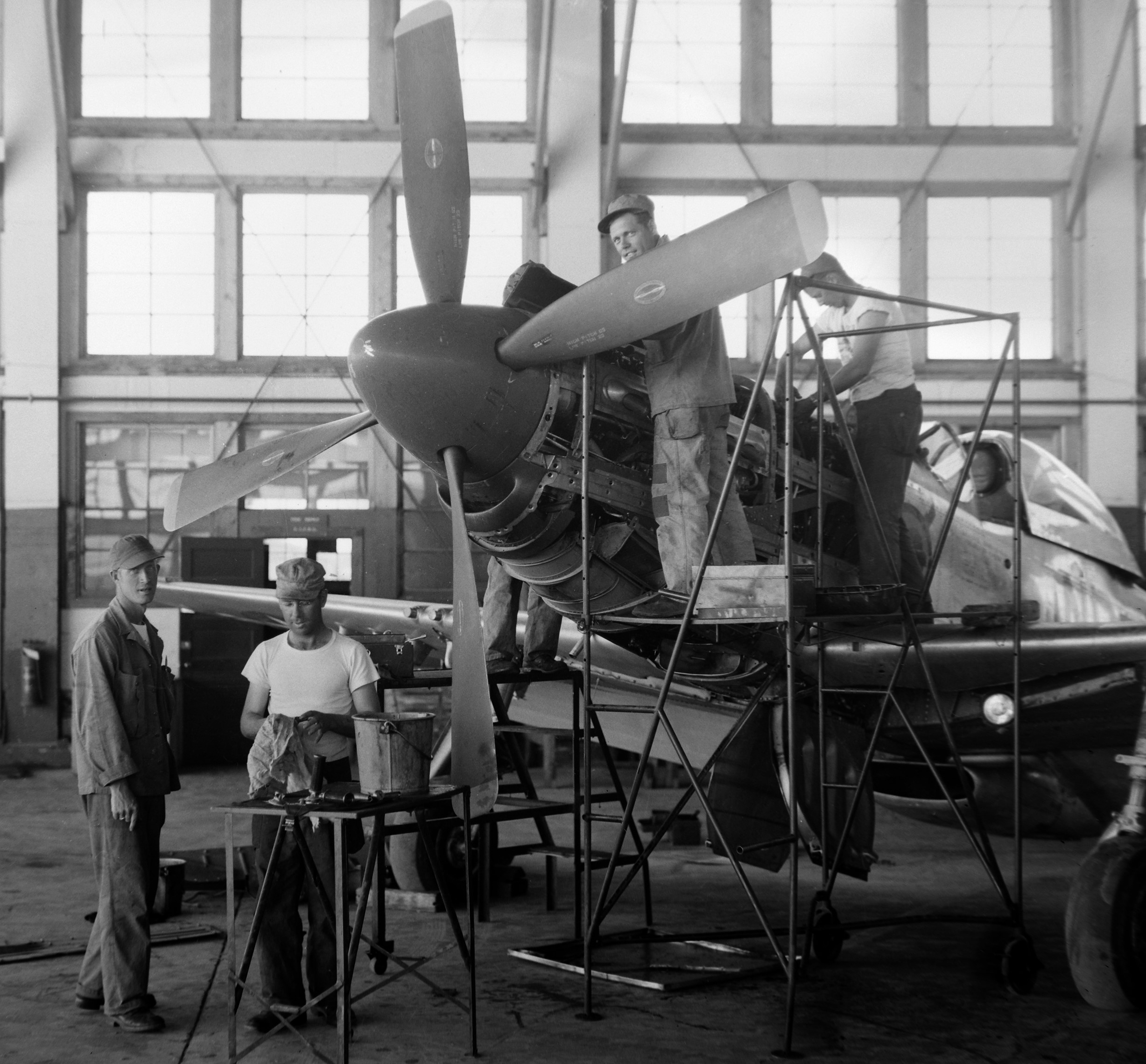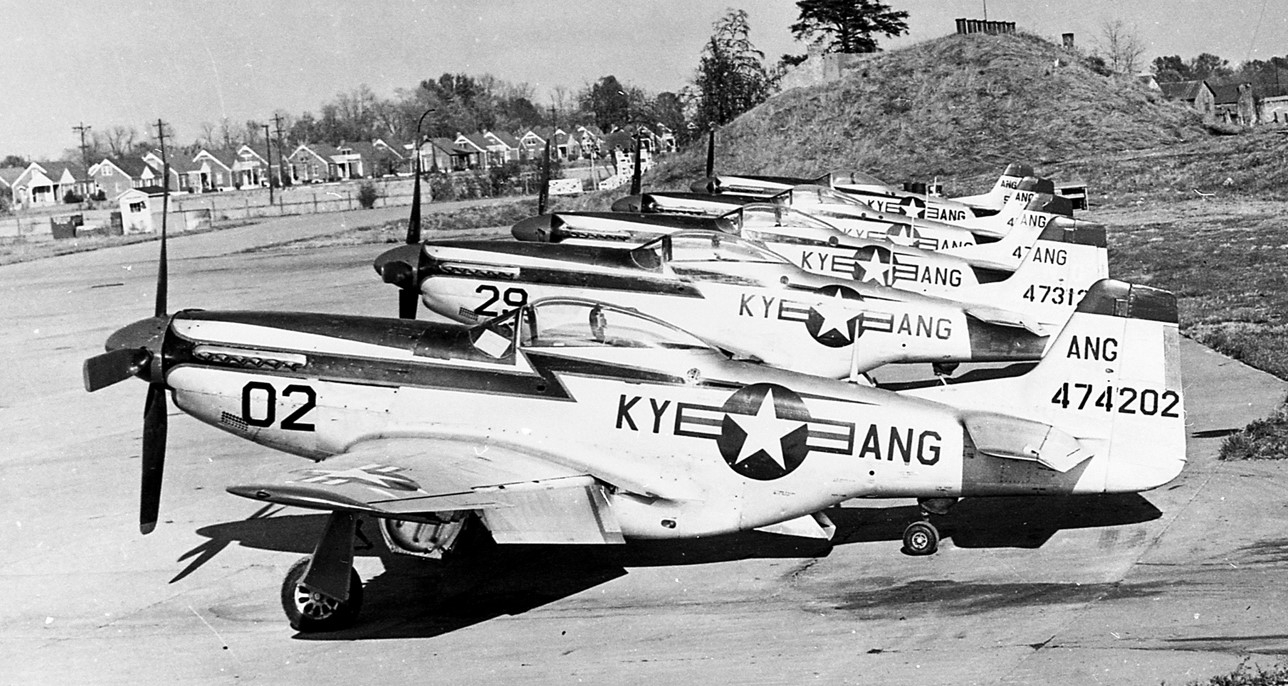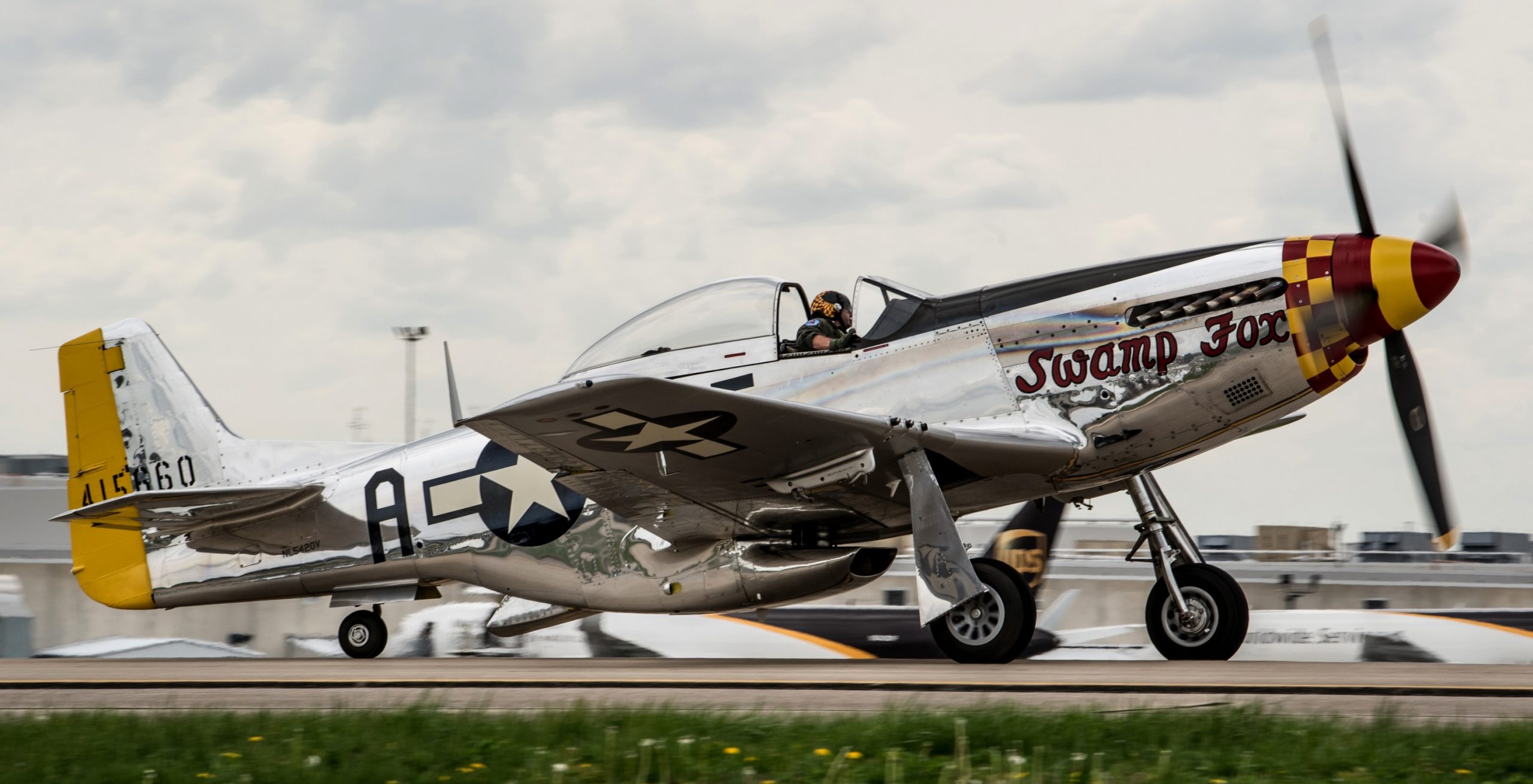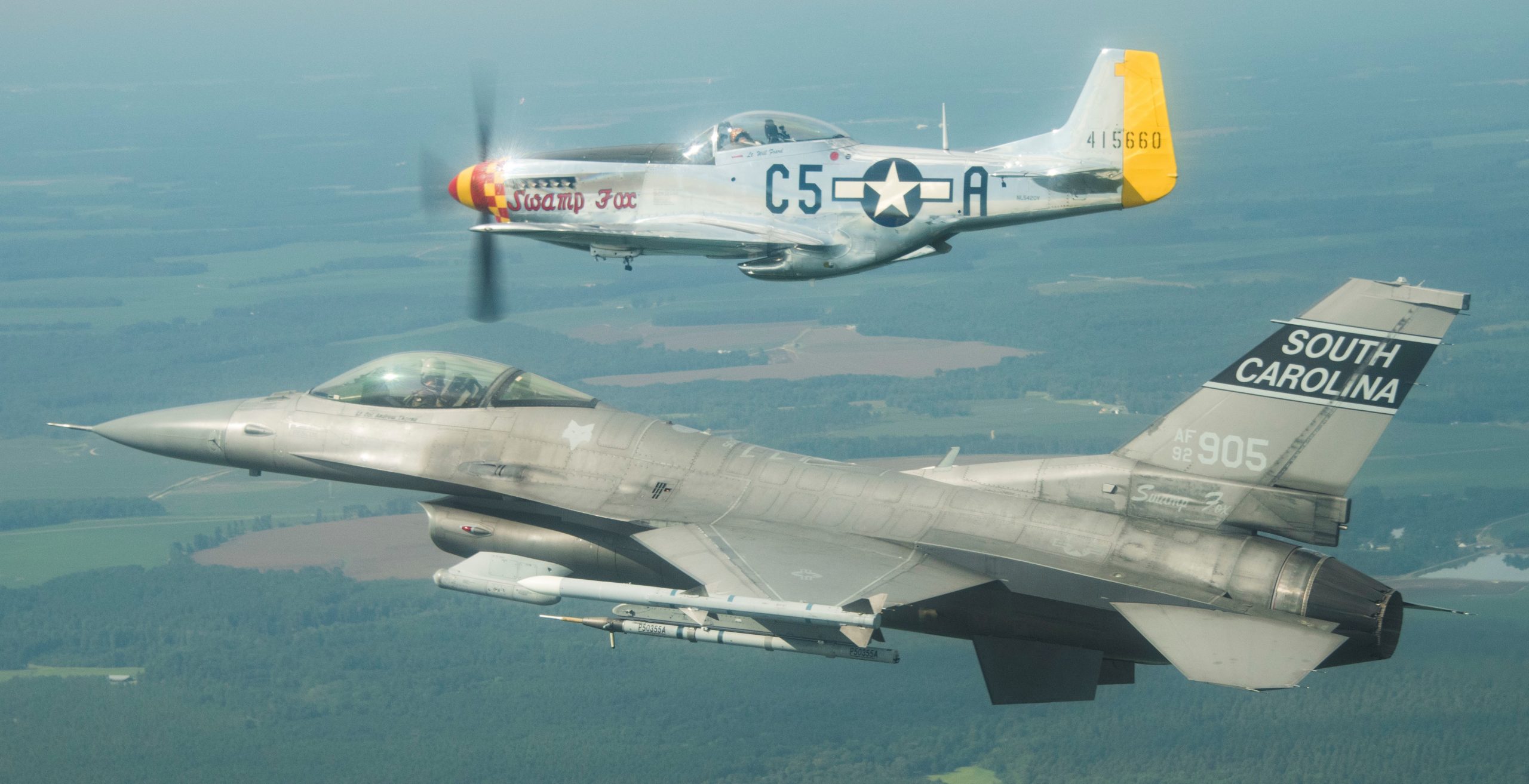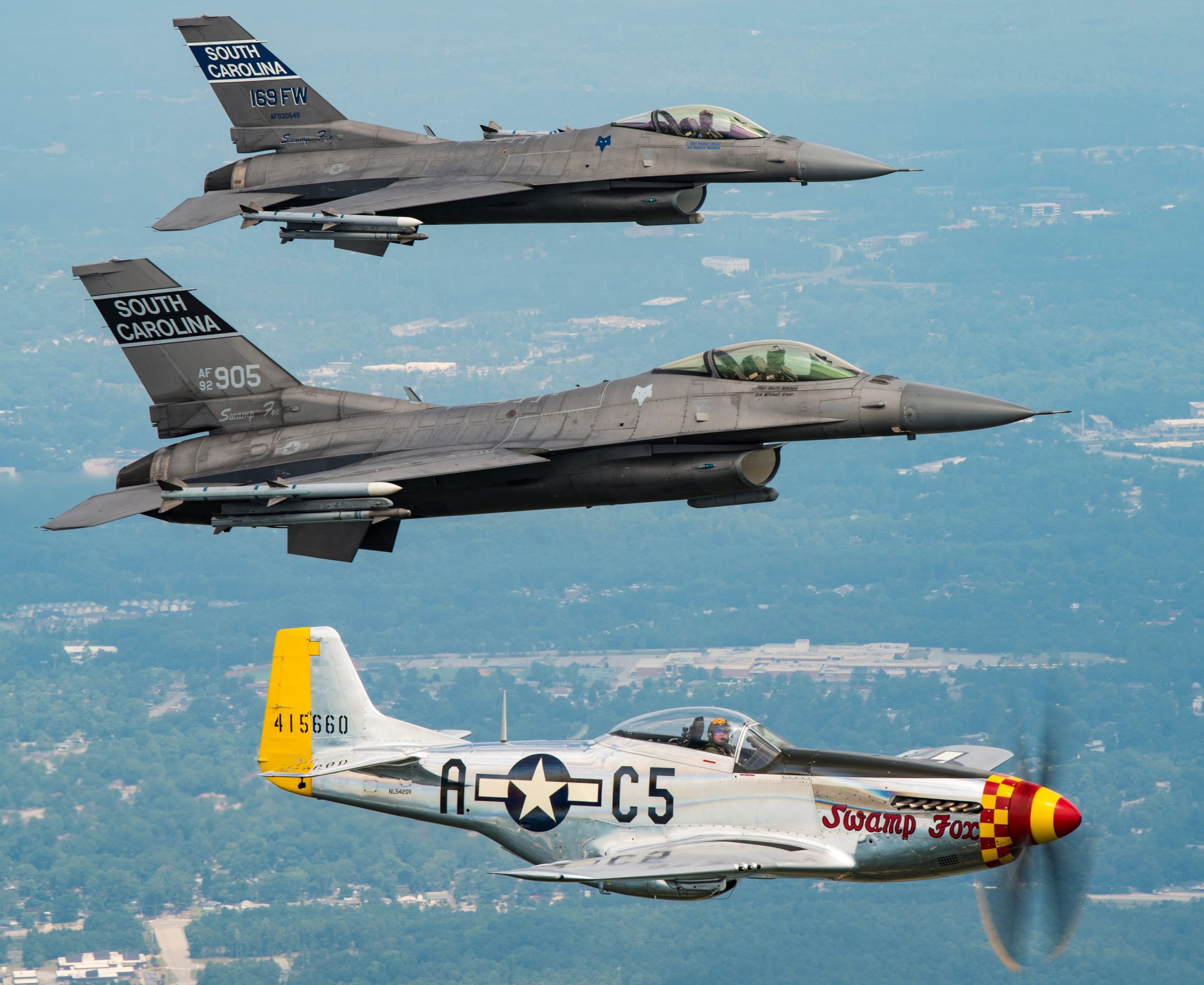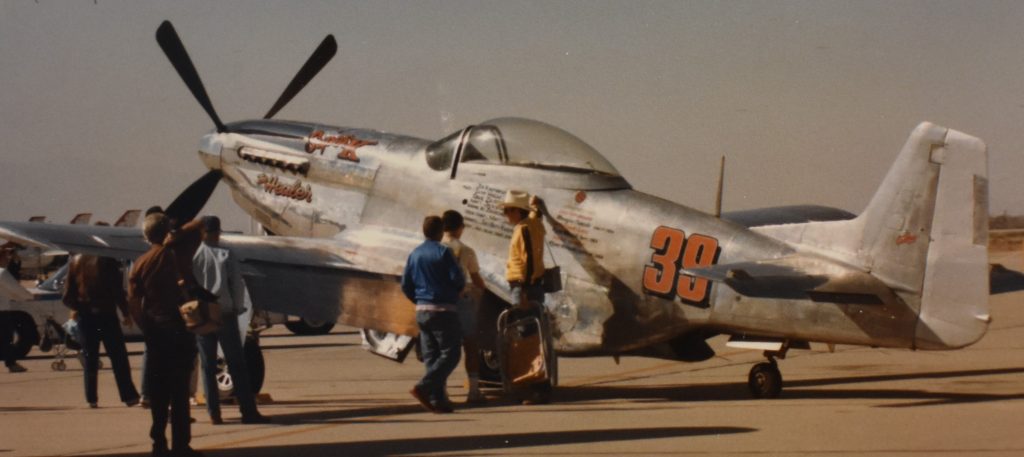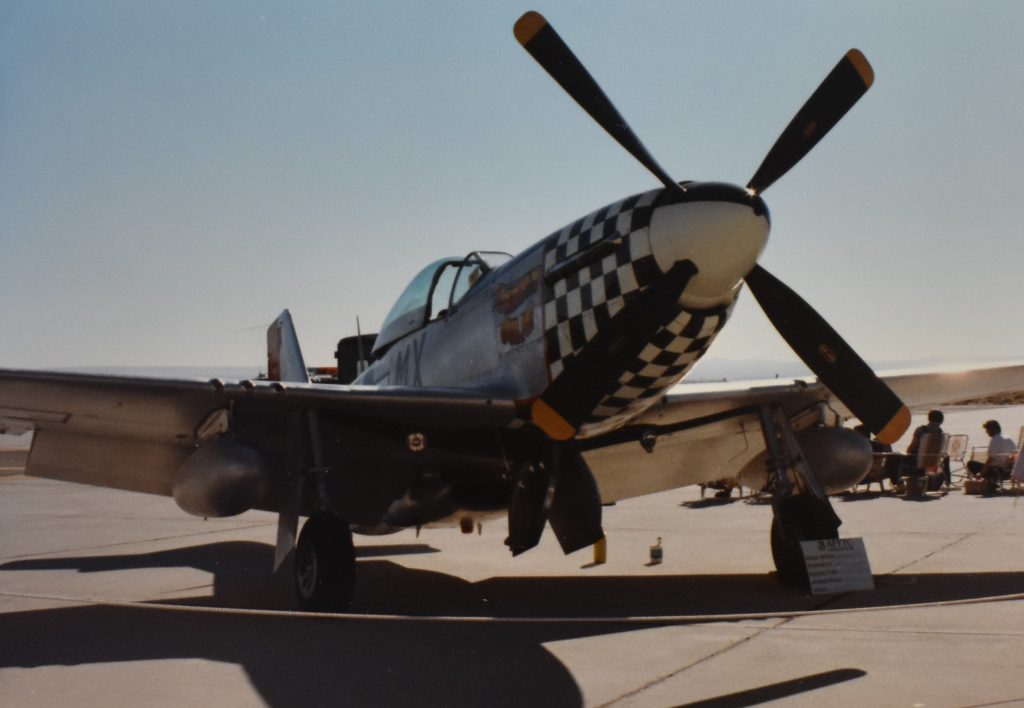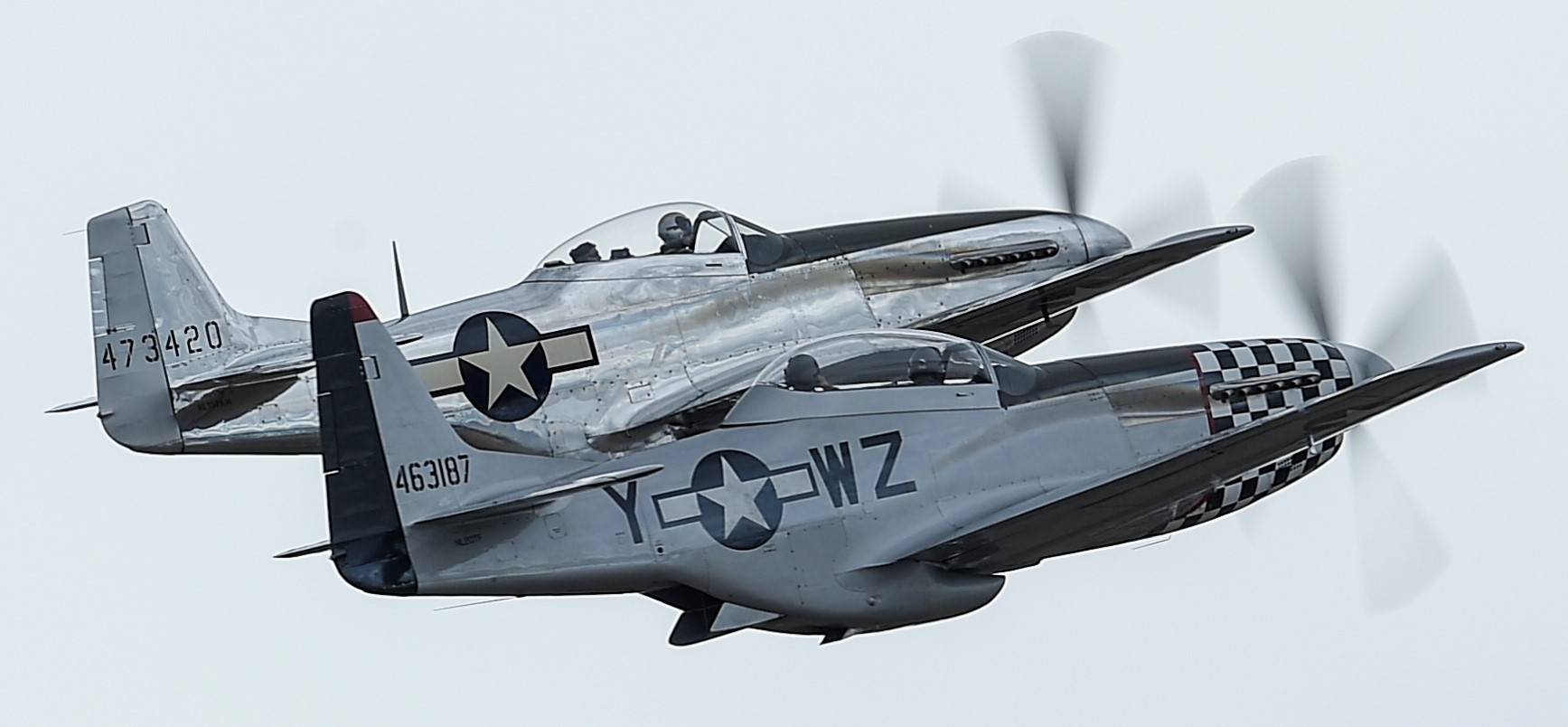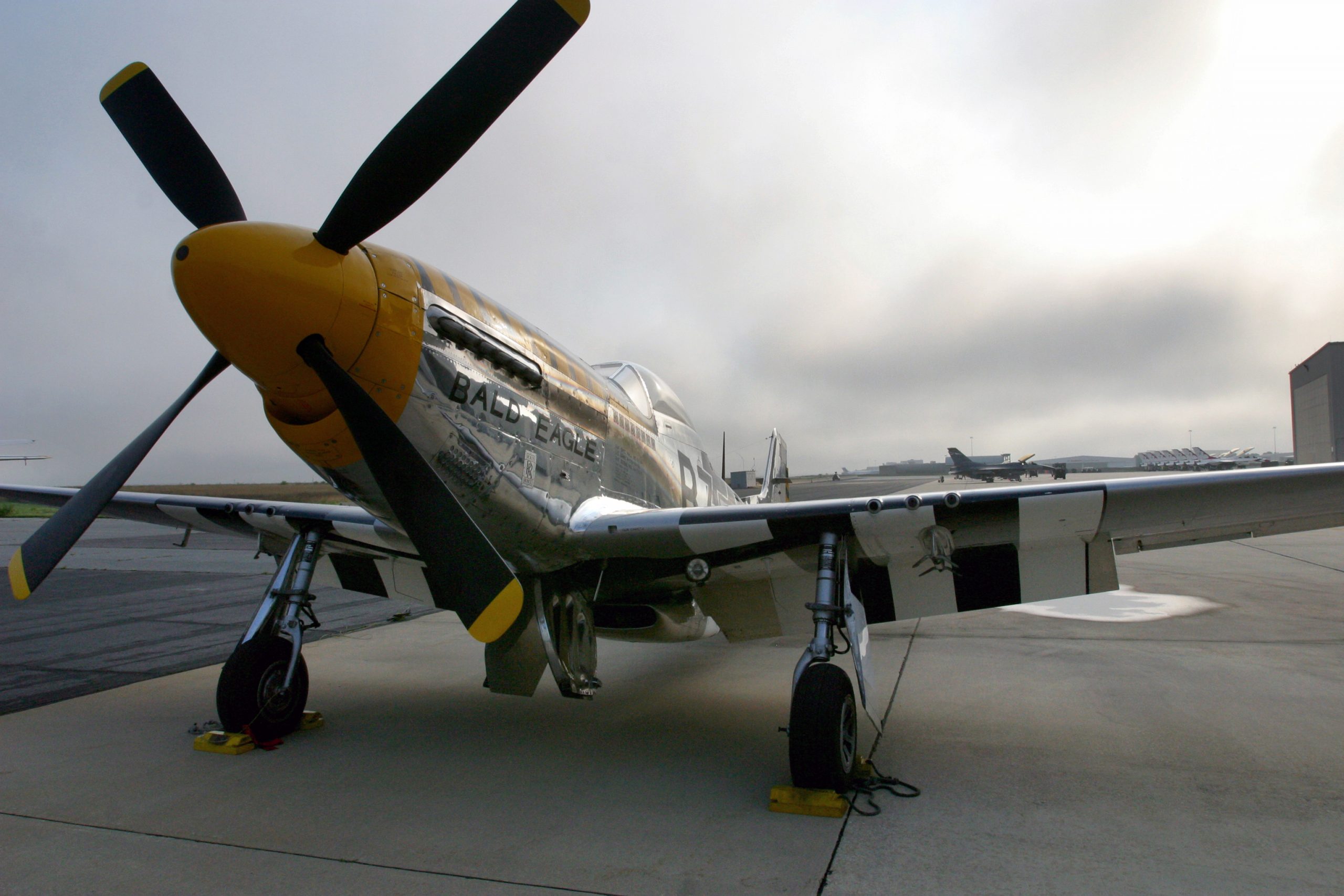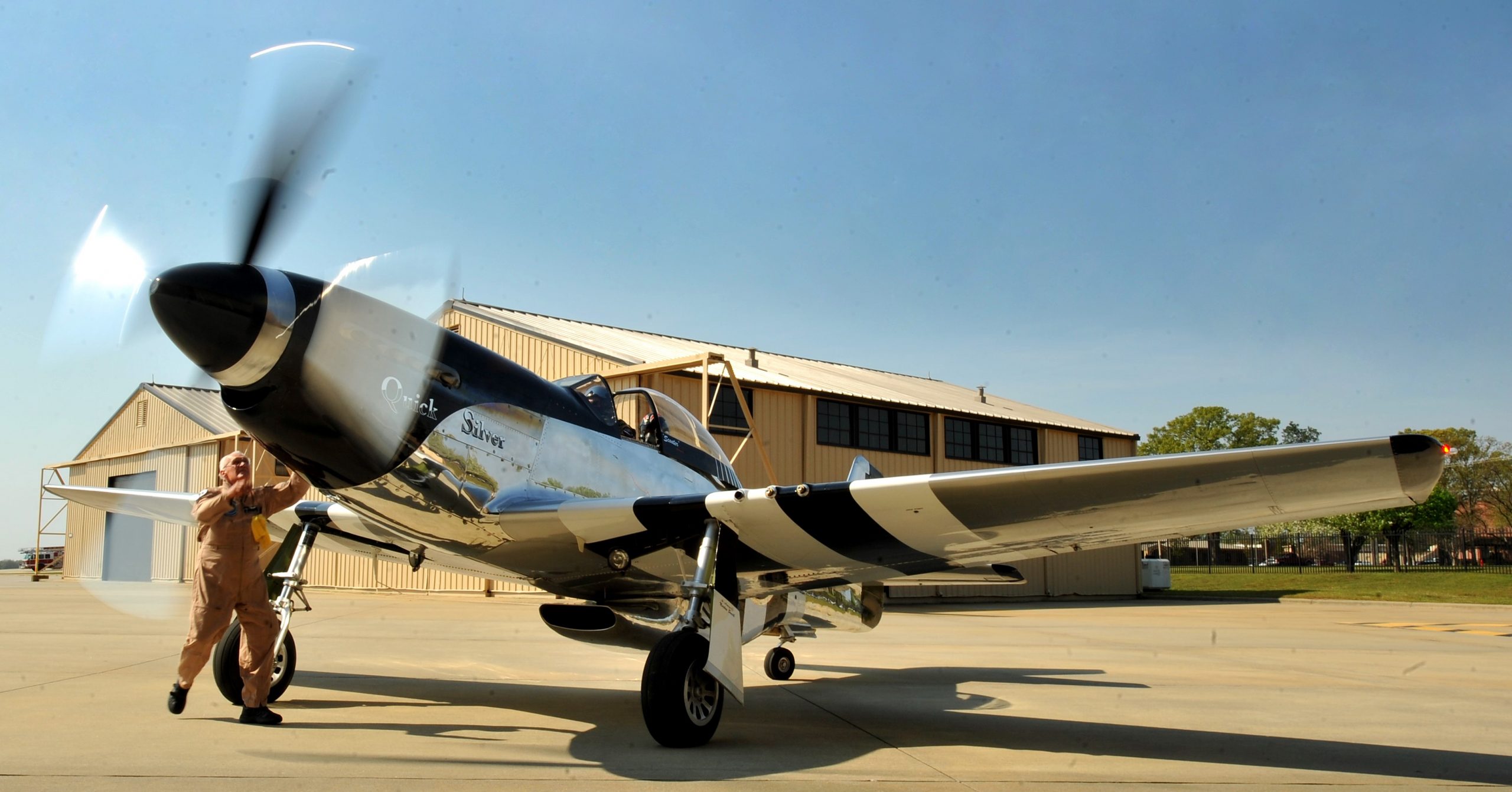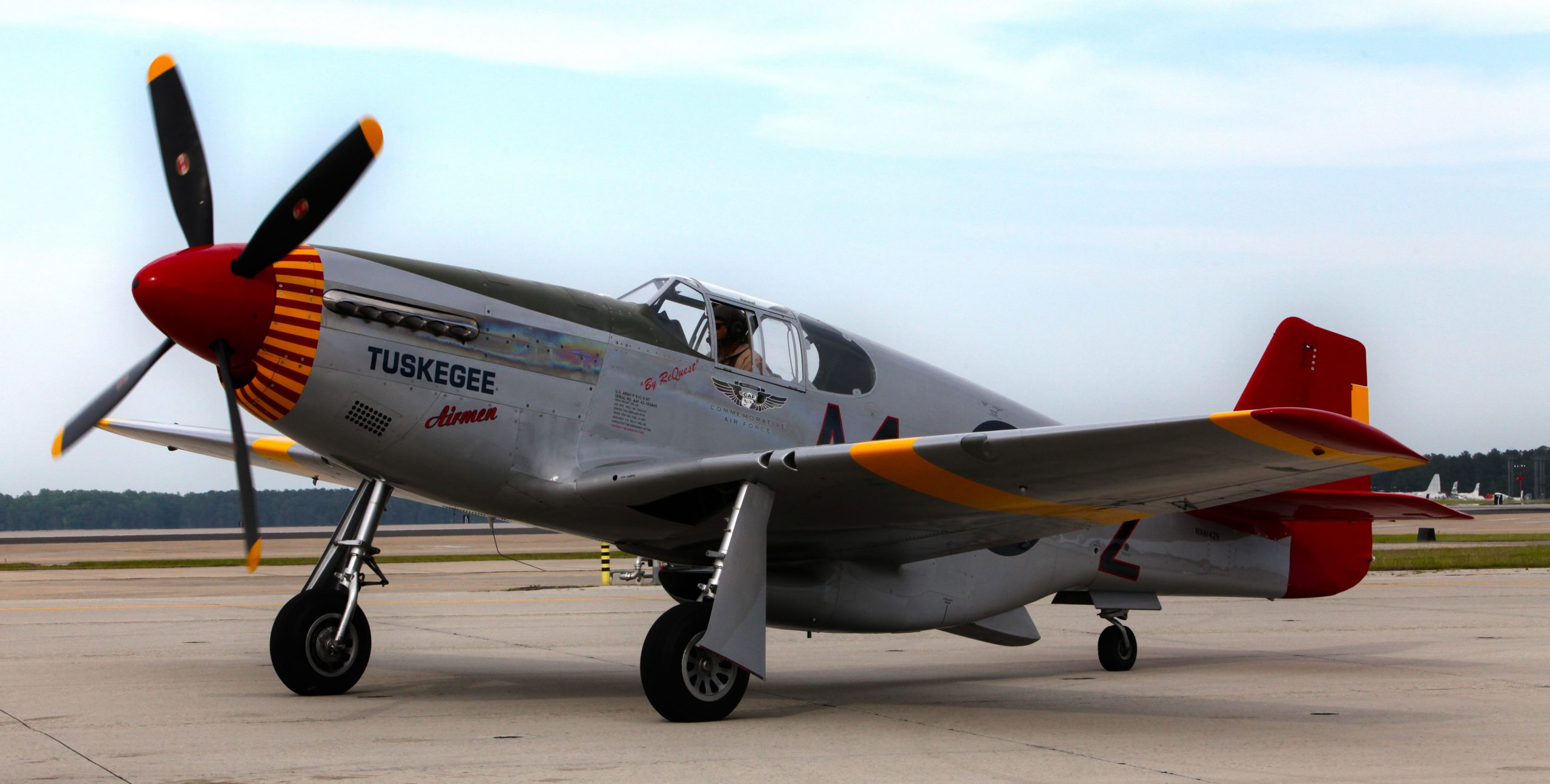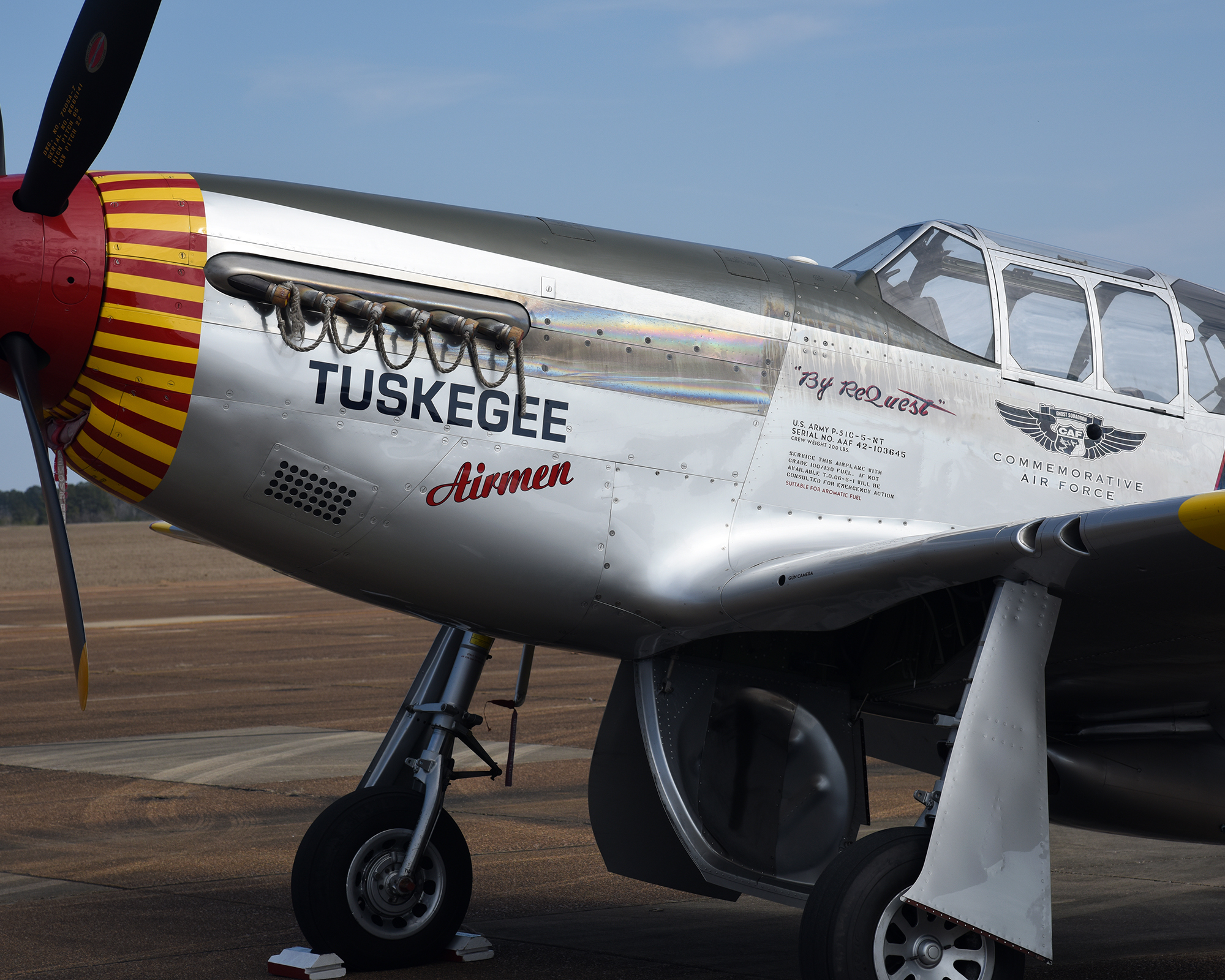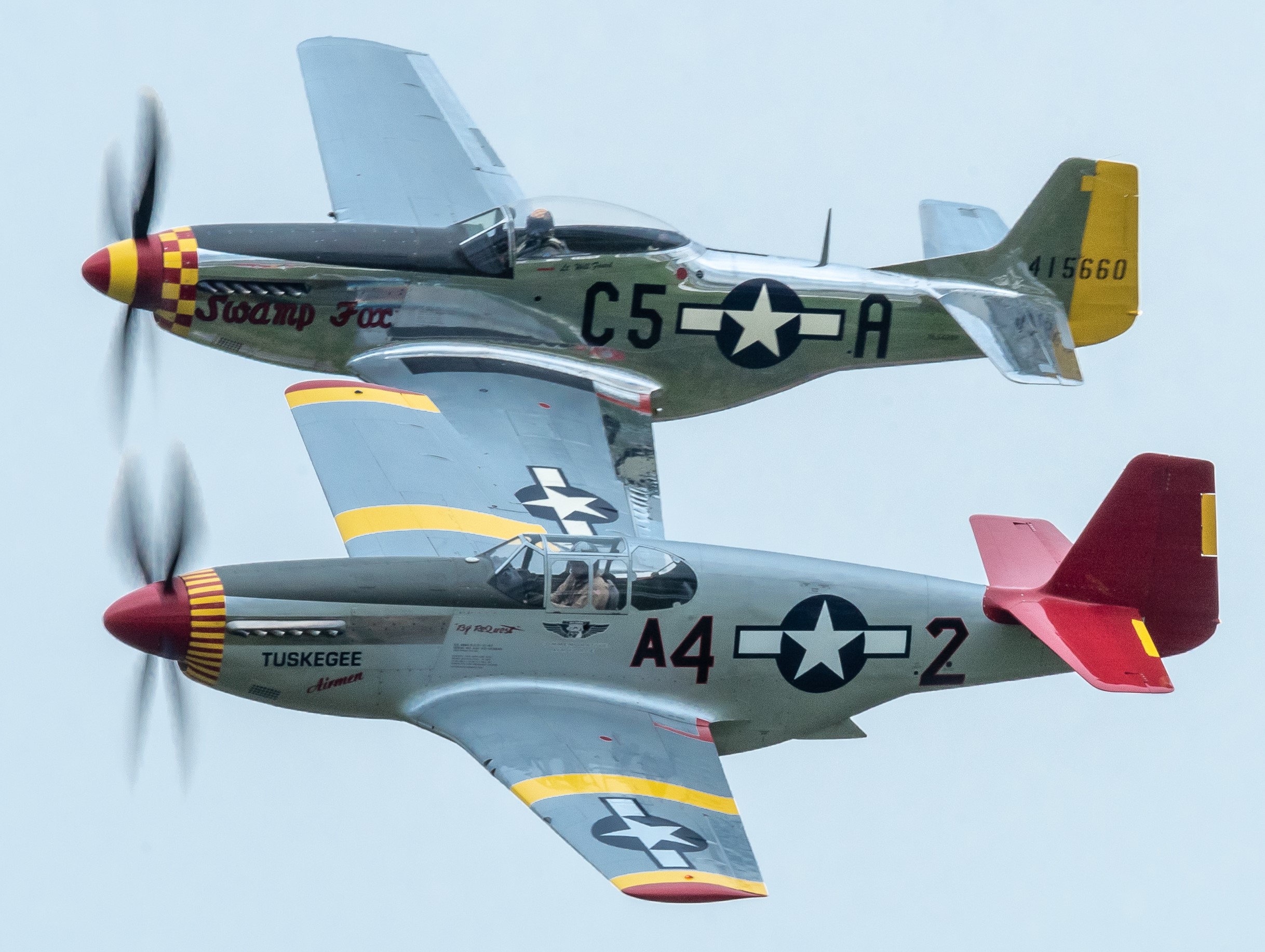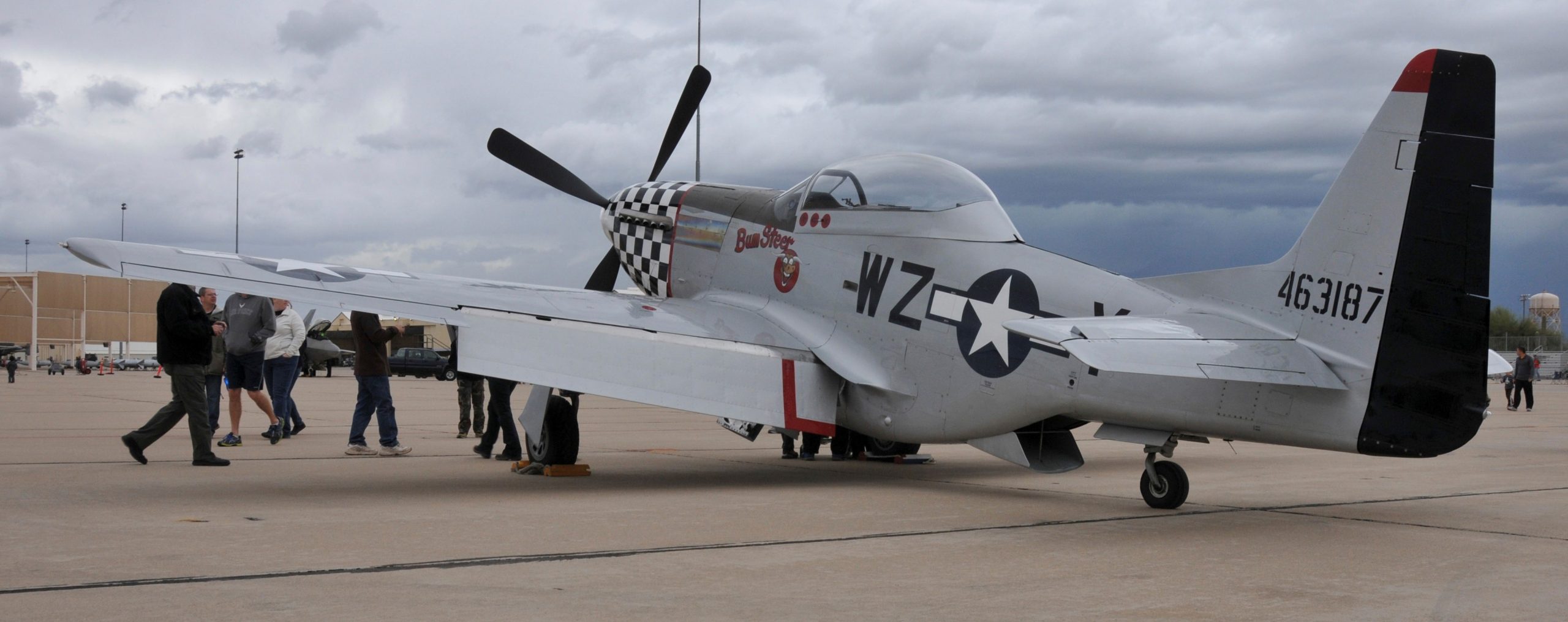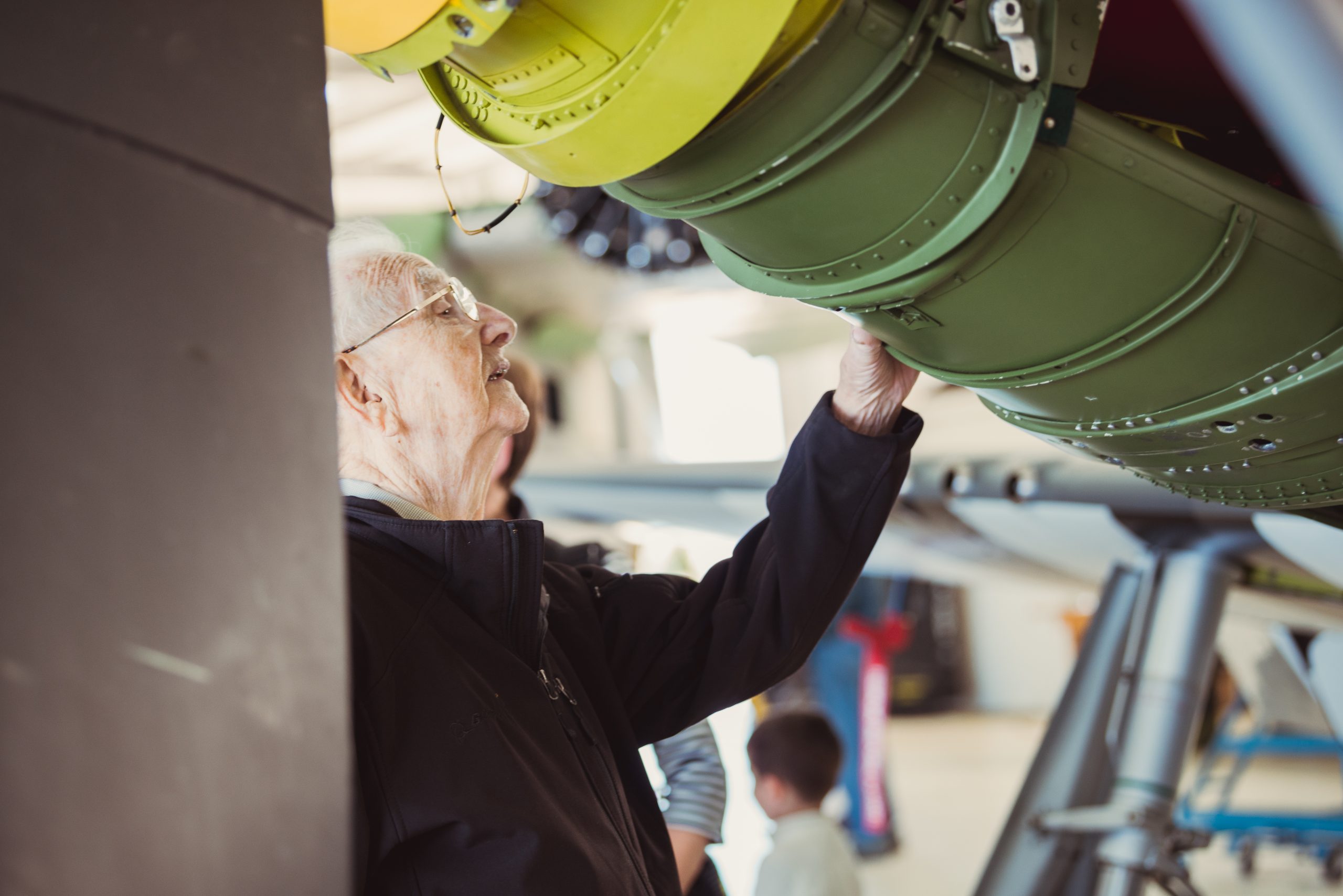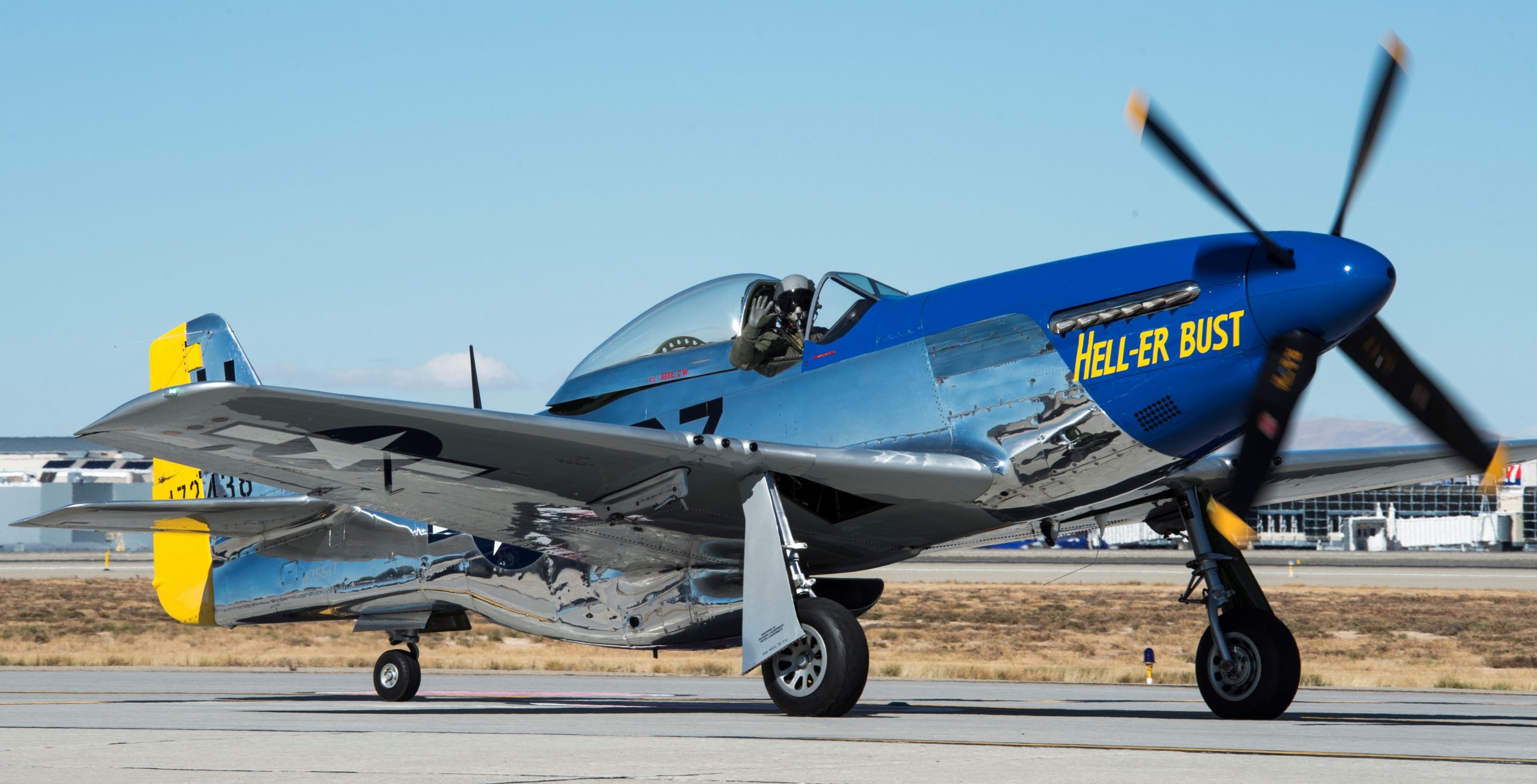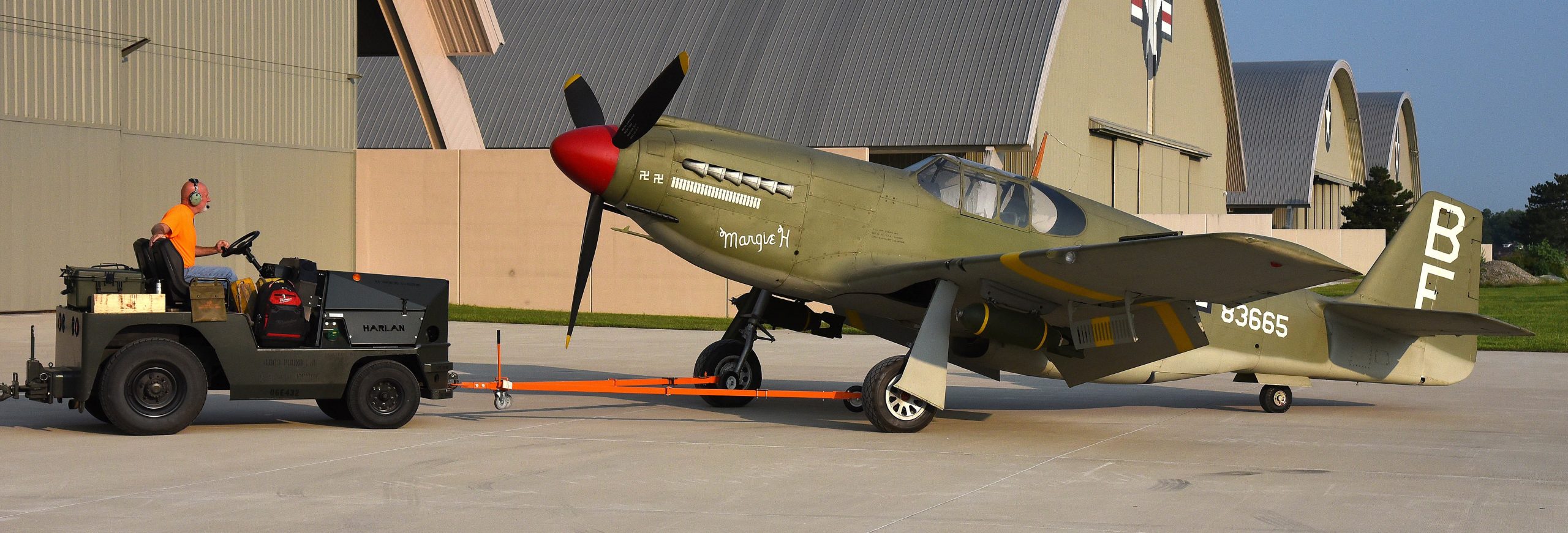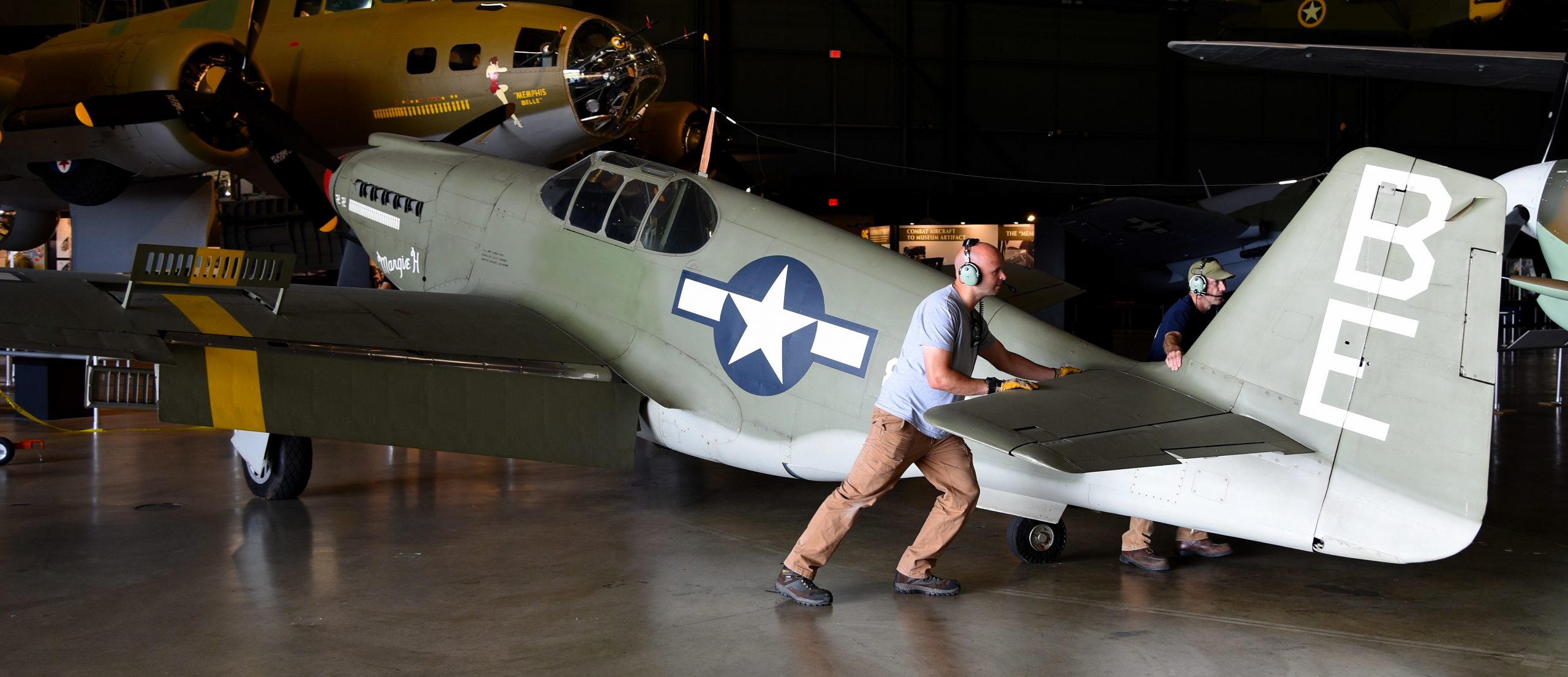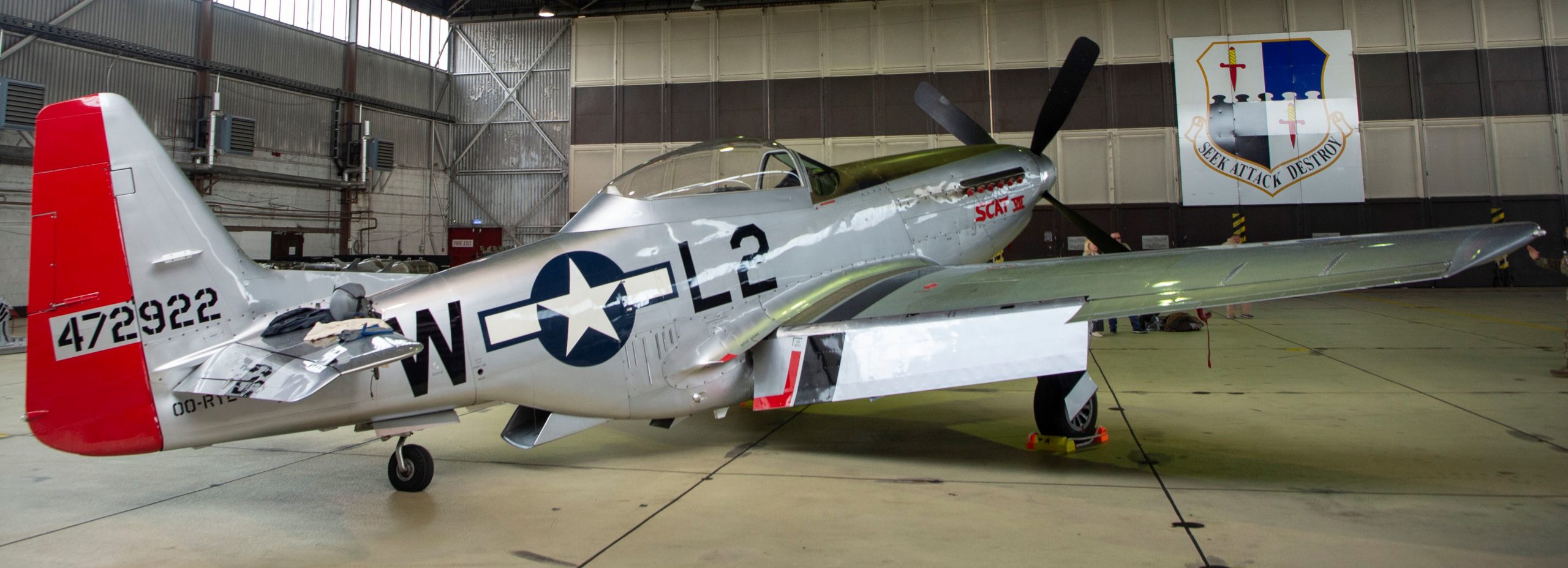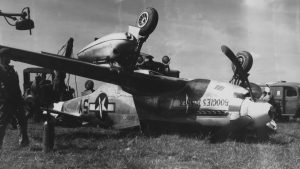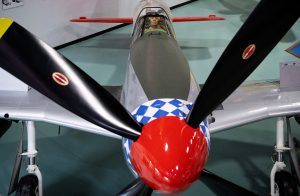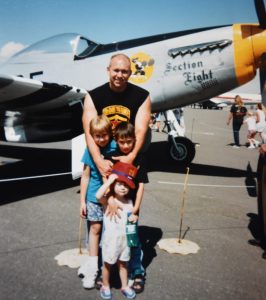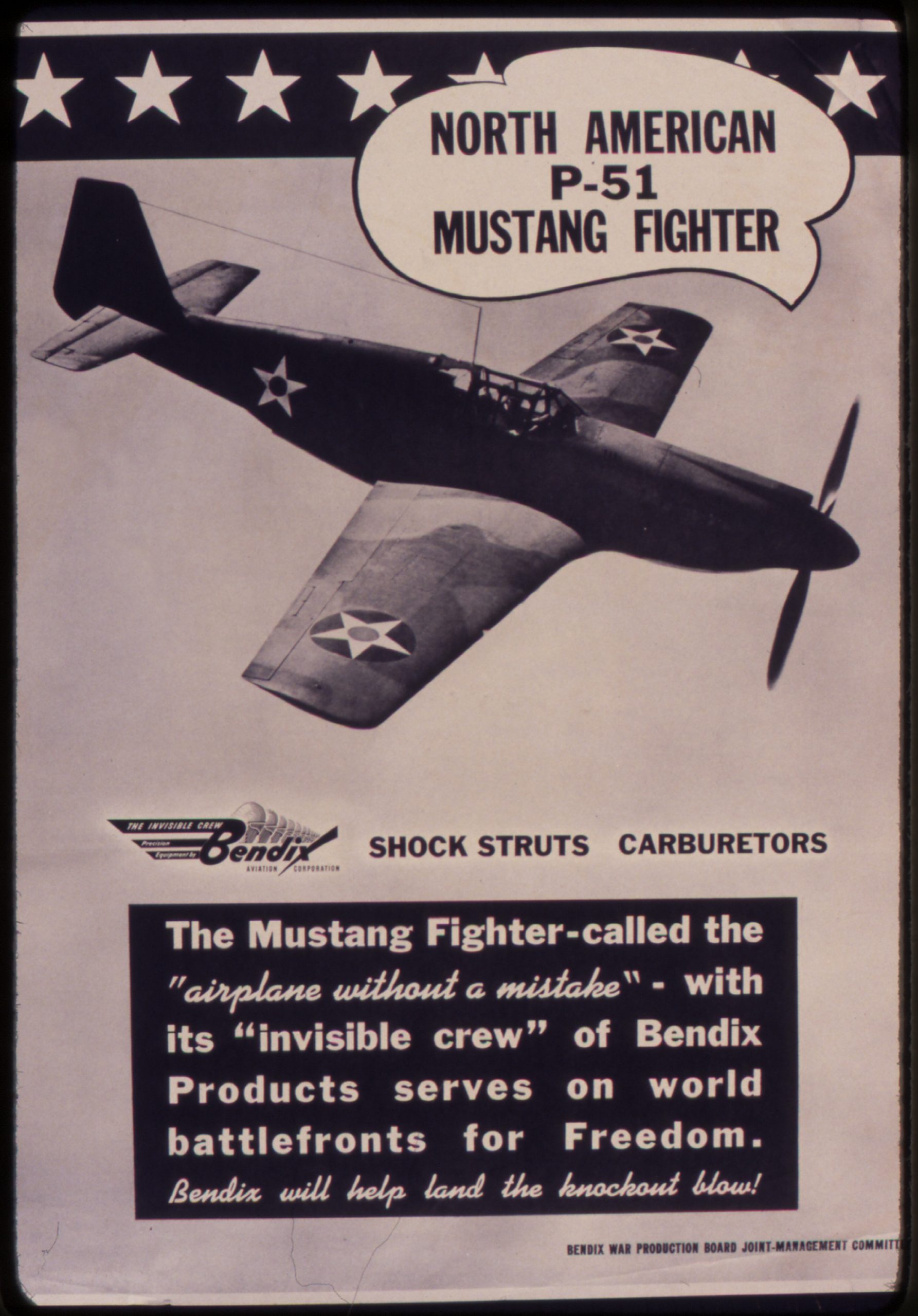 This war-time advertisement shows a NA-73/NA-83, Mustang Mark 1, built for the United Kingdom’s Royal Air Force. The Mustang Mark 1 was put into production, supposedly in 1941, with first deliveries to the British in February 1942. The name Mustang was supposedly the idea of one of the British officials overseeing the purchase of the NA-73/83.
This war-time advertisement shows a NA-73/NA-83, Mustang Mark 1, built for the United Kingdom’s Royal Air Force. The Mustang Mark 1 was put into production, supposedly in 1941, with first deliveries to the British in February 1942. The name Mustang was supposedly the idea of one of the British officials overseeing the purchase of the NA-73/83.
Notice the wing of this Allison engined P-51/Mustang Mark 1. The wing shape/armament changed from variant to variant. Many model kits of different Mustang variants incorrectly use the same P-51D wing.
USAAF (U.S. Army Air Force) and RAF (Royal Air Force) ground crews go over a P-51 Mustang Mark 1, Margate, England, United Kingdom, 01APR1943.
Photo of a NACA model of a 20mm gun armed Packard-Merlin engined P-51B. This is odd as the model has the 20mm guns of the P-51 Apache/Mustang Mark 1A, yet has the four bladed propeller of the P-51B Mustang/ Mustang Mark 3. This is the XP-51B prototype. Back then NASA was NACA (National Advisory Committee for Aeronautics).
North American Aviation (NAA) employees build a large scale model of the future P-51D(?), at the company’s Inglewood, California, location.
Brand new 20mm gun armed P-51 Apache (NA-91, for North American model 91), over the mountains of Southern California. Strangely, what the British called the Mustang Mark 1A was ordered in July 1940, before the Mustang Mark 1! At this point, the U.S. called the P-51 the Apache, the United Kingdom called it the Mustang. Eventually the U.S. changed their name for the P-51, and all subsequent P-51 variants, to Mustang. The recon version of NA-91 was called F-6A.
Right-off the Inglewood assembly line, brand new P-51s, supposedly in October 1942. The information with the photo calls them P-51As, yet you can clearly see the mounts for 20mm guns, which the A version did not use. P-51As (NA-99) used wing mounted .50 caliber guns (12.7mm).
Orders for the NA-99/Mustang Mark 2s were placed in the middle of 1942 , the official ‘first flights’ of P-51As began in February 1943. Recon versions of NA-99 were called F-6B.
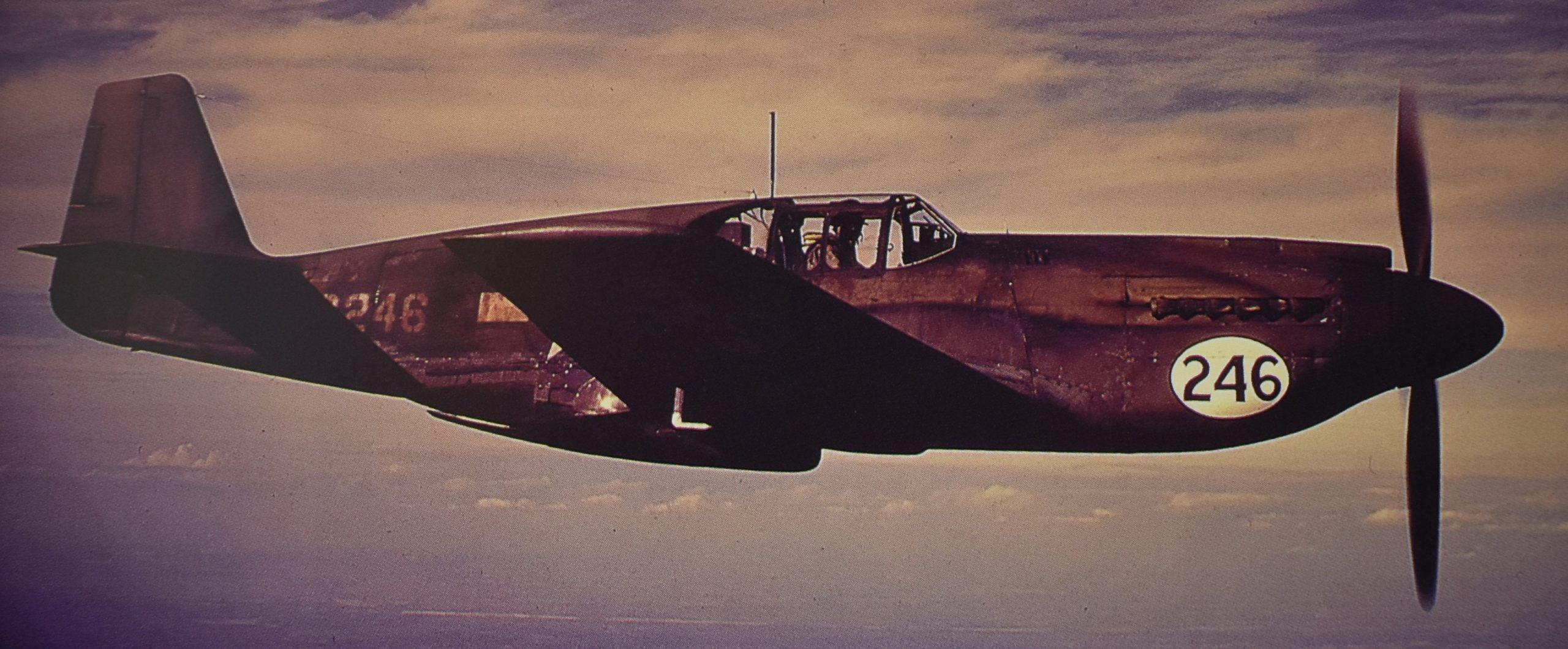
In this photo of a Mustang Mark 2 (P-51A) you can see the earlier Mustangs had very small radiator air intakes.
In April 1942, the U.S. Army Air Force (USAAF) ordered the NA-97, a ‘Mustang’ designed specifically for ground attack missions. The USAAF designated it as the A-36 Apache/Invader, to differentiate from the P-for-pursuit P-51 Mustangs.
This is not a P-51D. In late 1942, a P-51B (note the wing) was modified with the bubble canopy, and exhaust manifolds, that would be used on the P-51D Mustang Mark 4.
Another non-P-51D(?), this time with totally straight leading edged wings, but with the six .50 cals mounted in the wings, as well as bomb and rocket pylons. It is the structurally different P-51H, which first flew in 1945, however, the info with the photo claimed it is a P-51D.
In 1943, NACA used modified Mustang Mark 1s (notice the empty .50 cal gun throughs in the nacelle) to test laminar wing designs and called the experimental planes (two of them) the XP-51 Mustang. However, there were many ‘XP-51’s, such as the XP-51Bs which were used in the U.S. to test the Packard license built Rolls Royce Merlin motor.
By July 1944, NACA claimed its XP-51s were the oldest Mustangs in existence.
‘Malcolm Hood’ canopied P-51B The Iowa Beaut (formerly Man o’ War) over United Kingdom, sometime early 1944 as the plane was shot down over Germany on the 11th of September of that year.
Sometime in late 1943 or early 1944, somewhere in Italy, a U.S. Army Air Force (USAAF) A-36 Apache/Invader. Notice the .50 cal guns protruding from the plane’s chin, just behind the propeller.
A-36 Invader of the Mediterranean Allied Air Forces.
P-51B/C (Mustang Mark 3 to the British) landing somewhere in Merry ol’ England, March 1944.
P-51D (Mustang Mark 4 to the British) ‘Baby Mine’, flown by then First Lieutenant Stephen C. Ananian, 505th Fighter Squadron, 339th FG, based at Fowlmere, England, 1944.
‘Baby Mine’ crew chief Staff Sergeant Joe C. Nicholas. Back then there was no U.S. Air Force (USAF), it was the U.S. Army Air Force (USAAF).
Somewhere in France, November 1944, this USAAF photo shows a Malcolm canopied P-51B/C recon plane, officially called F-6C. You can see the camera pointing out of a hole cut in the rear window, behind the pilot.
P-51Ds over Italy, March 1945. Notice the wing shape.
The arrows in this photo show where a P-51B/C was modified with ‘form-up’ lights on the side of its fuselage. They were used to help other Mustangs fly in formation at night.
P-51C over China, sometime between January and July 1945, note the shape of the wing.
A weathered P-51C(?) somewhere in China, early 1945.
P-51D Mustangs on Iwo Jima, 25MAR1945.
U.S. Marine Corps silent film, by Sergeant E.G. Begston, of USAAF P-51D Mustangs operating from Airfield #1 on Iwo Jima, 10MAR1945:
Color silent film, by A.J. Clarke, of P-51Ds operating from Airfield #1, Iwo Jima, June 1945:
An RF-51D reconnaissance Mustang, during the Korean so-called UN Police Action during the early 1950s. When the U.S. Air Force (USAF) was created in 1947, P-51s became known as F-51s.
Silent film of F-51D ground operations sometime during the Korean Conflict:
Here’s some more old silent film, date & location unknown:
1:1 scale P-51B(?) in NACA’s Full Scale Wind Tunnel.
Official U.S. Department of Defense video, by Matthew Hilborn, about the P-51:
The information with the photo calls it an ‘air flow direction vane’, attached to the top of a NACA XP-51D wing, but look close, it is actually a ‘semispan’ (cut in half length-wise) model of a supersonic rocket plane.
July 1945, the final production version of the Mustang actually came out at the end of World War Two, but never saw combat. The P-51H was a lighter weight long-range version of the P-51D, it is structurally different from the P-51D.
NACA wing-glove experiment, 1946. Notice the taller tail fitted to the P-51B, which would become an identifier of post-world-war Mustangs.
1955 and still called NACA. Notice the taller post-world-war tail.
The F-51D had laminar flow wings. This specific Mustang became NACA #127 and would be modified with the taller tail.
When they restored NACA 127, they even reinstalled the experimental reduced scale semispan airfoil wing plate.
North Dakota Air National Guard F-51Ds, Hector Field, 02MAY1948.
North Dakota Air National Guard, June 1948.
‘DAPSO South’ silent color film, by somebody with last name of Meyer, of Military Assistance Program (MAP) F-51Ds on La Aurora Air Base, Guatemala, 30AUG1969:
Kentucky F-51Ds, just after the Korea conflict. Tail #474202 was resurrected as ‘Swamp Fox’ and has been flying in recent air shows.
Formerly Kentucky Air National Guard’s 474202, modern day Swamp Fox takes-off from the Thunder Over Louisville air show, 11APR2019.
Size comparison between Swamp Fox and South Carolina Air National Guard F-16 Falcons.
When my father, William Lewis Hutchins, worked at Edwards Air Force Base (AFB) he always attended the ‘Open House’ shows at Edwards, and sometimes Mojave Desert neighbor George AFB. These photos are dated 1986, but don’t indicate which Open House air show (Edwards or George).
F-51D and tall tailed TF-51 trainer, fly over Davis-Monthan AFB, Arizona, 12FEB2017.
Atlantic City Air National Guard Base, New Jersey, 17AUG2004.
Bill Yoke, owner of Quick Silver, makes final checks before takeoff from Shaw AFB, South Carolina, 19MAR2012. Quick Silver was restored 13 years prior.
Red Tails P-51C, Marine Corps Air Station Cherry Point, North Carolina, 04MAY2012.
Red Tails P-51C, Columbus Air Force Base, Mississippi, 10FEB2020.
P-51D ‘Swamp Fox’ and a Red Tail P-51C, over Bowman Field in Louisville, Kentucky, 17APR2021.
TF-51 trainer ‘Bum Steer’ at Davis-Monthan AFB, during the Heritage Flight Training Course, 01MAR2014.
Video by Sidney Lee, P-51s fly-by Gray Army Airfield at Joint Base Lewis-McChord, Washington, 06JUN2014:
Anybody have the old-but-gold Monogram 1:48 scale P-51D Mustang kit? Here’s the color of the ram air scoop under the chin. Veterans check out a restored Mustang during a 339th Fighter Group reunion in Wisconsin, 30SEP2017.
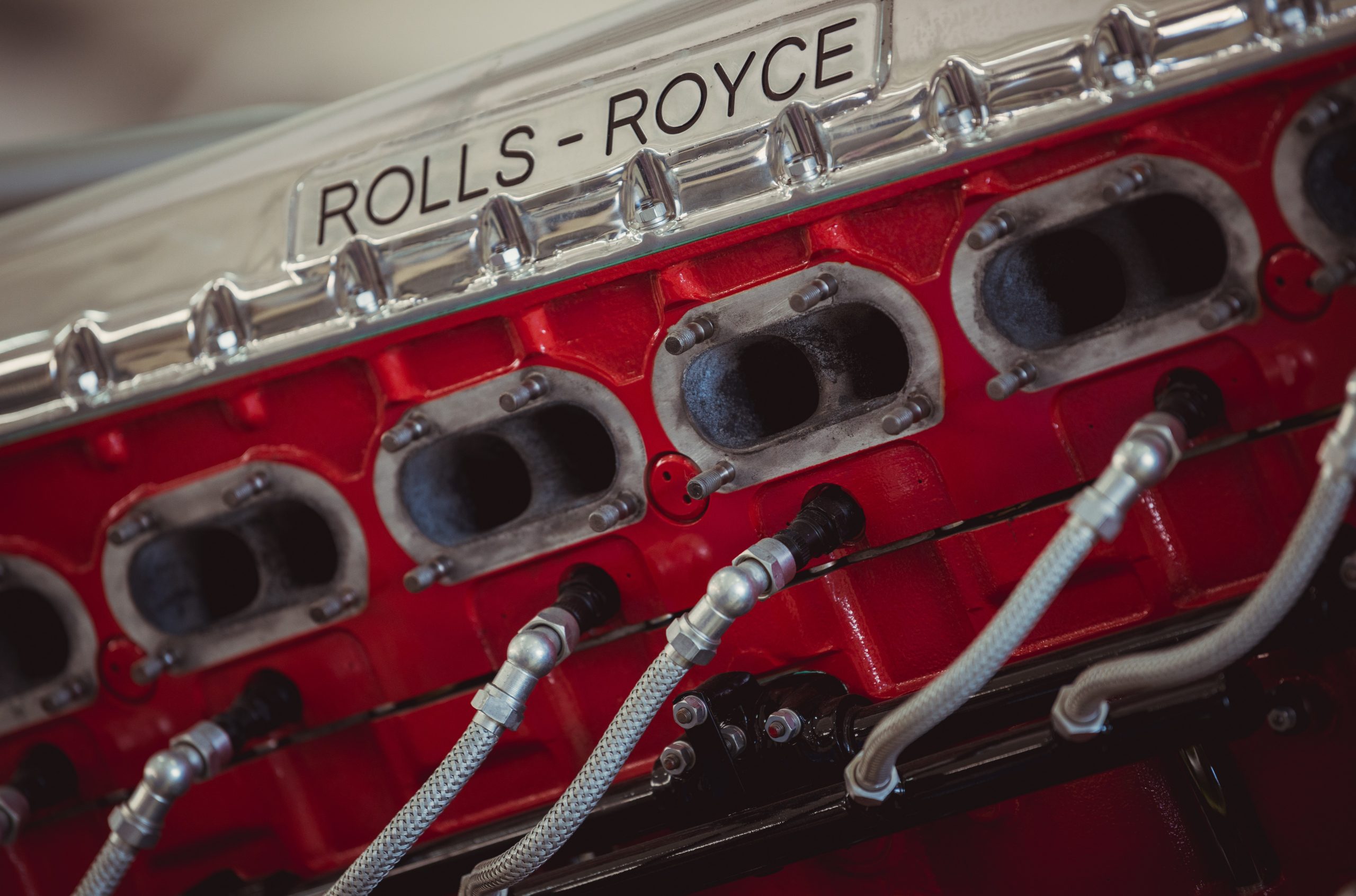
Close-up look at the Packard-Rolls Royce Merlin motor’s exhaust ports. Wisconsin Air National Guard photo by Staff Sergeant Ryan Campbell.
Gowen Field, Idaho, Gowen Thunder Open House and Airshow 14OCT2017.
USAF video, by Senior Airman Jaye Legate, of ‘Heritage Flight’ P-51Ds flying over Davis-Monthan AFB, Arizona, 09FEB2017:
North American A-36A Apache waiting to be moved into the World War Two Gallery at the National Museum of the U.S. Air Force, Wright-Patterson AFB, Ohio, 13AUG2018.
Video by Staff Sergeant Philip Bryant, whistling P-51D shows-off during the Twilight Show at Barksdale AFB, Louisiana, 17MAY2019:
‘SCAT VII’ supposedly was the last aircraft flown by iconic Brigadier General Robin Olds during World War Two (notice the taller tail). It paid Spangdahlem Air Base, Germany, a visit in May 2019. Robin Olds’ daughter, Christina, was giving a lecture about her father’s exploits as a three-war-ace.
Excellent size comparison between ‘Val-Halla’ and F-35, at Hill AFB, Utah, 17JUN2020.
U.S. Air Force Heritage Flight Foundation video, rear cockpit view from F-51 Mustang, 13FEB2022:
Crash Landings:
USAAF P-51 MUSTANGS, ENGLAND, 1944-45
Lady Alice & other survivors: 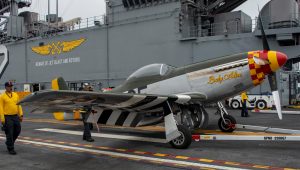 STILL FLYING AFTER 75 YEARS!
STILL FLYING AFTER 75 YEARS!
PAINTING A 1:1 scale P-51 WITH VINYL DECALS?
Pocatello Airport:
Crazy Eight P-51D MUSTANG, OLE YELLER FLIES ON IN IDAHO
Kit Bashing: ITALERI P-51 MUSTANG-1 OUT OF BOX REVIEW (the wrong wing)

